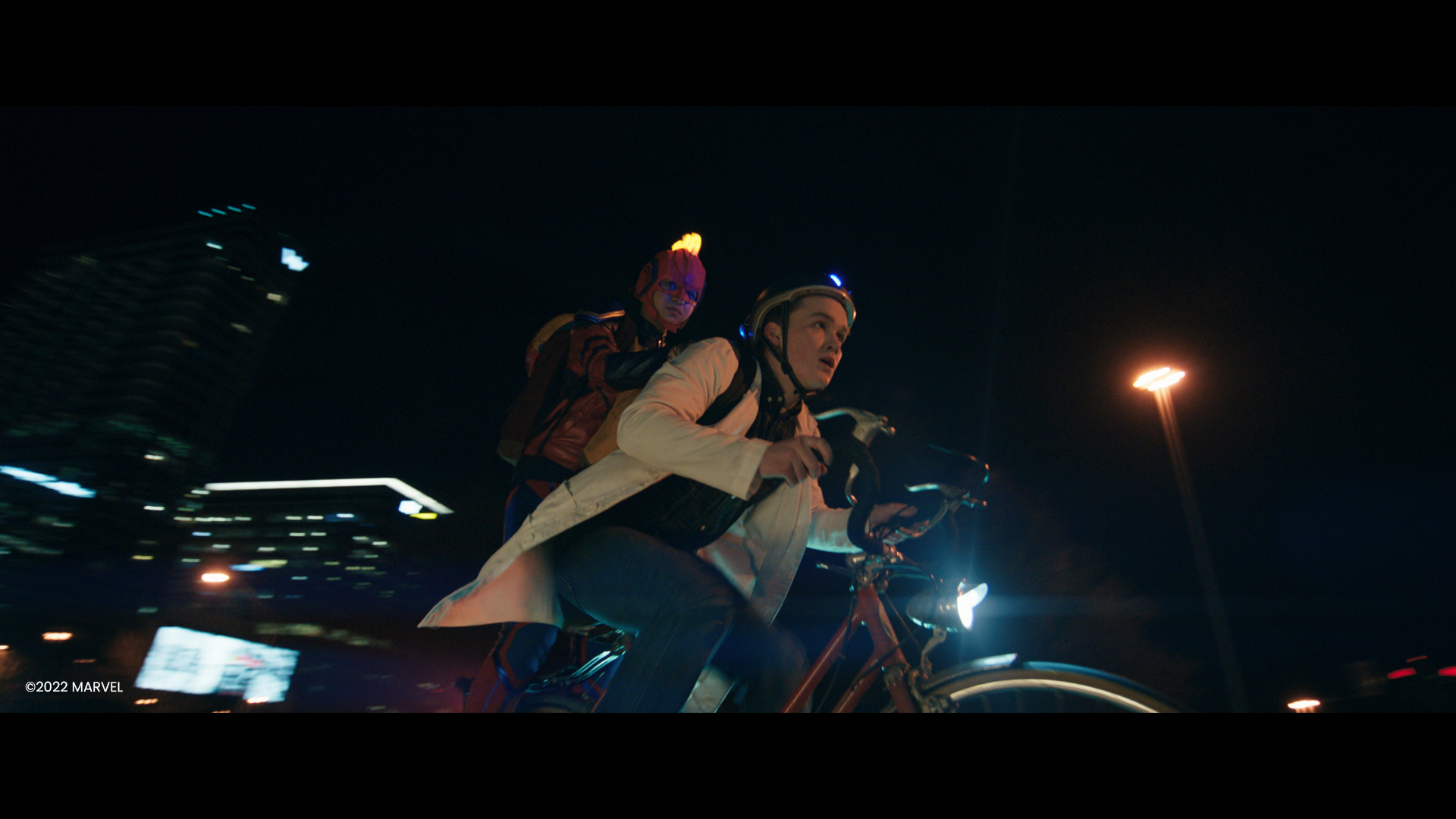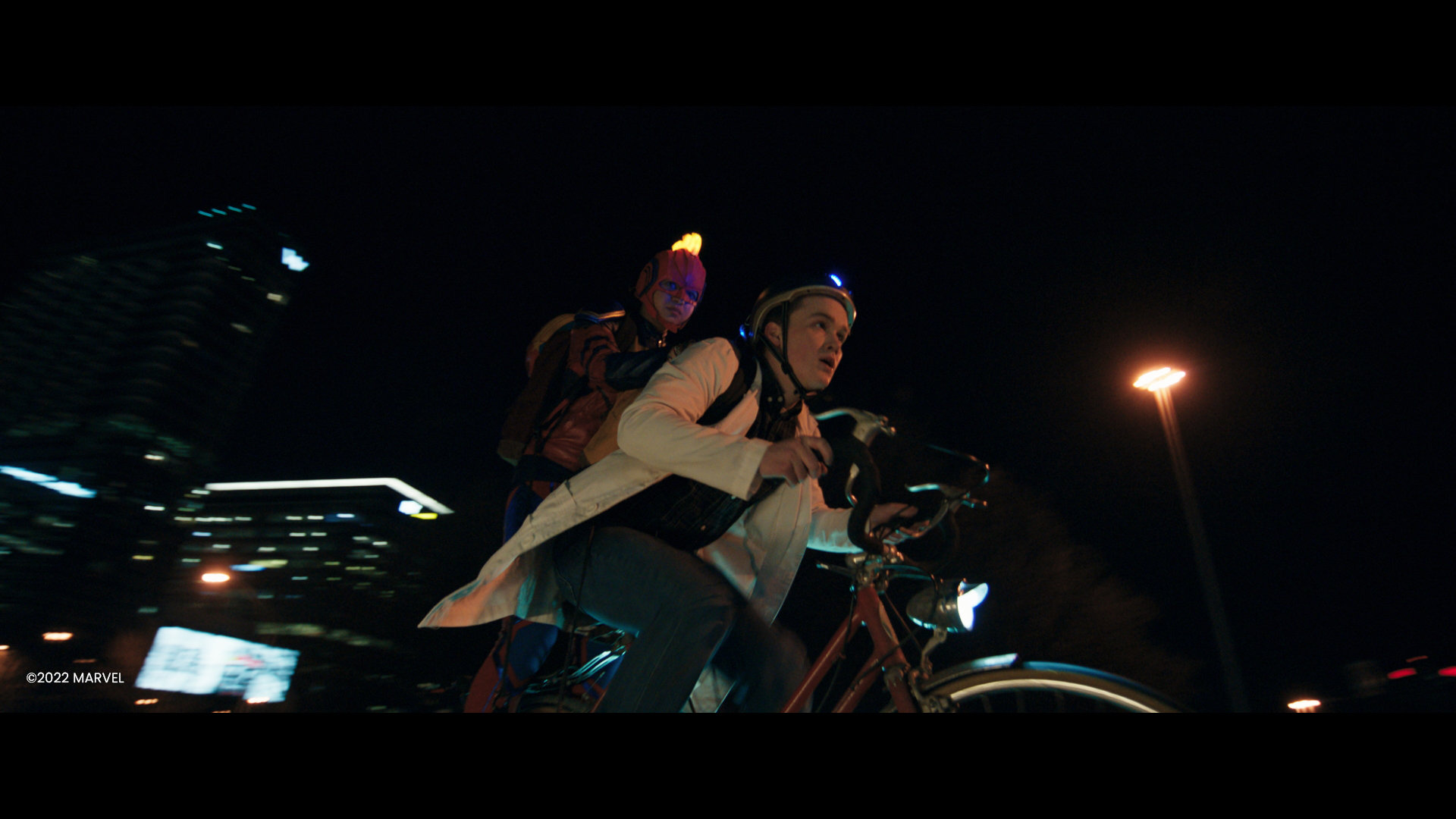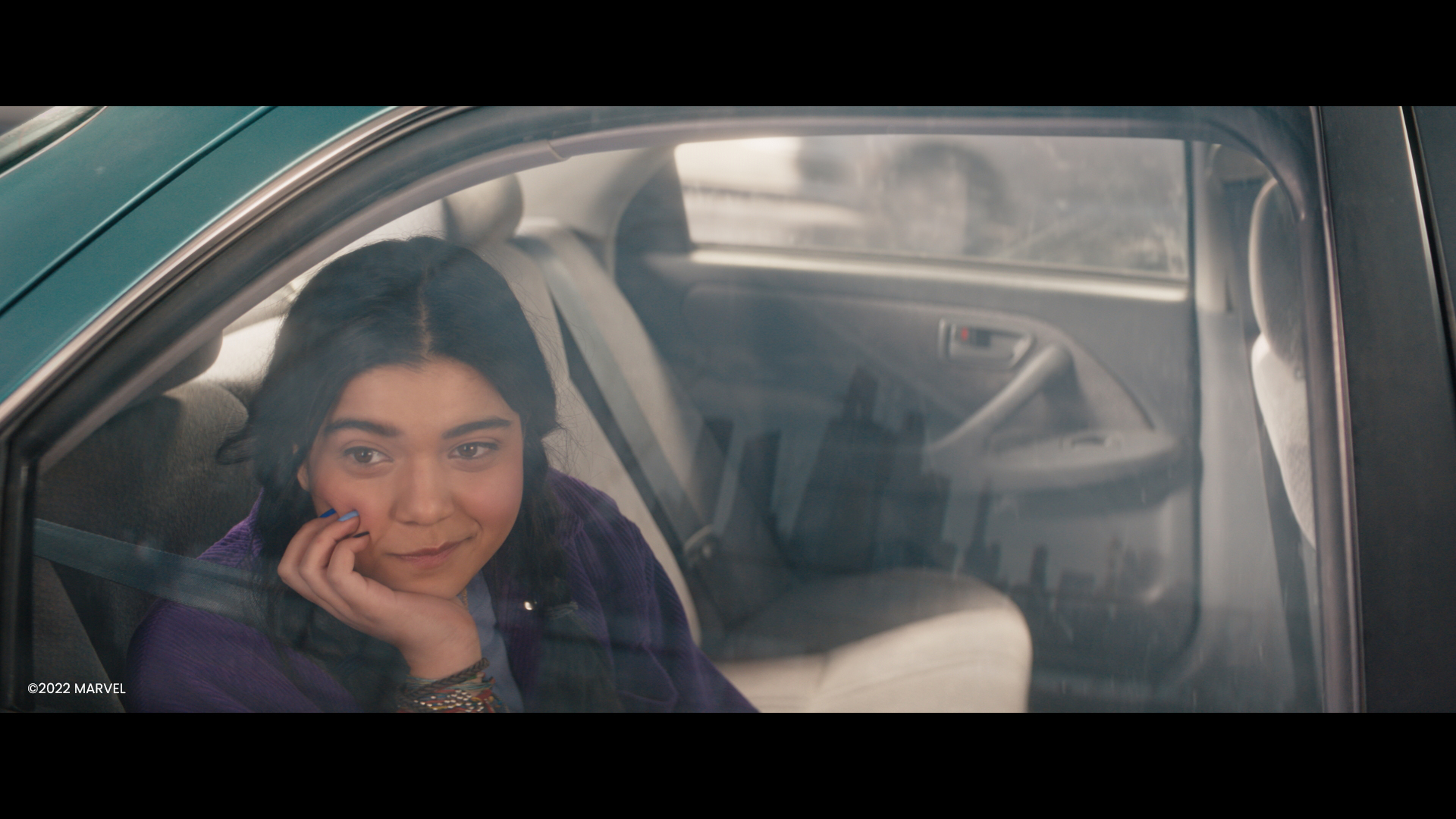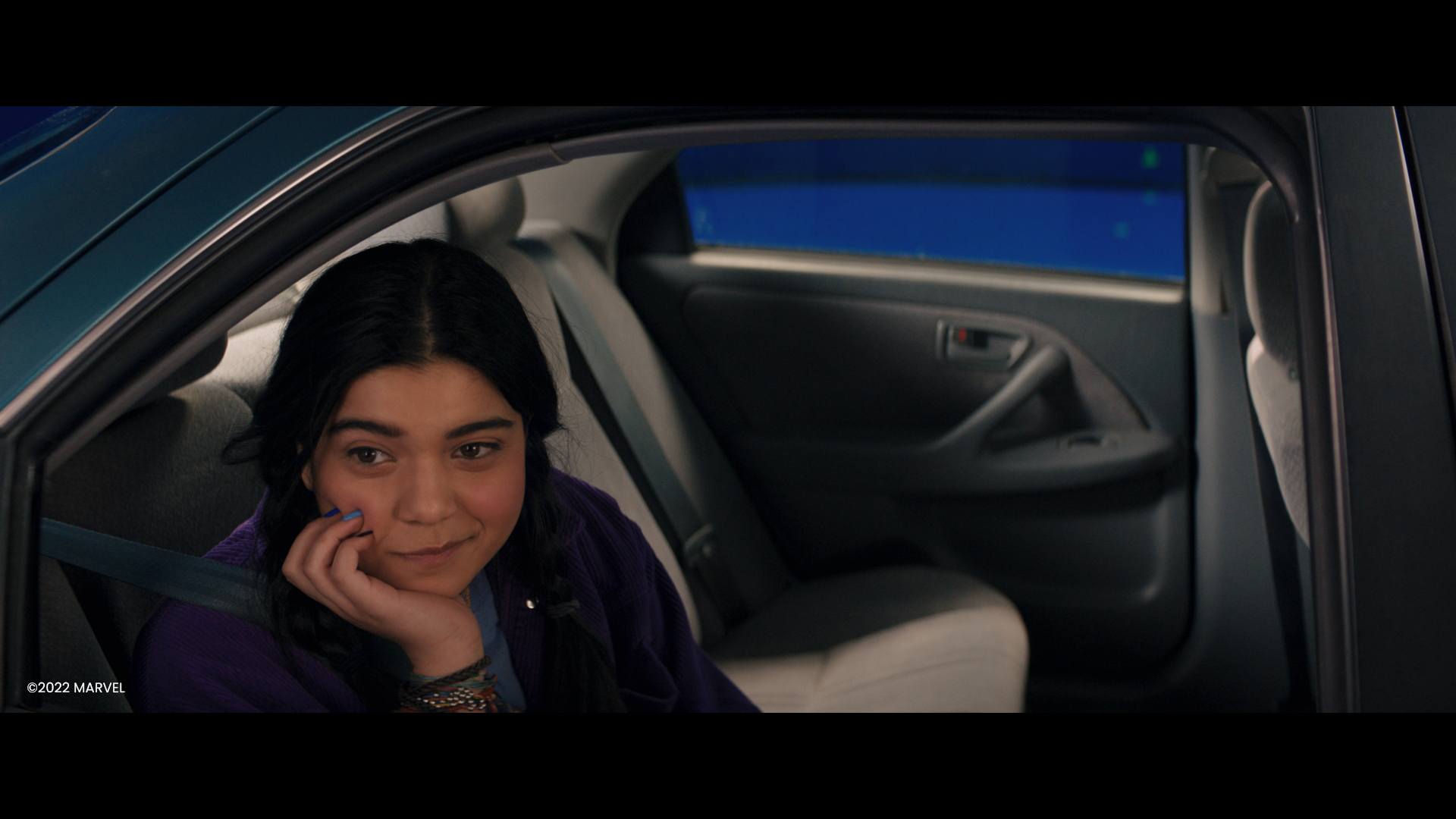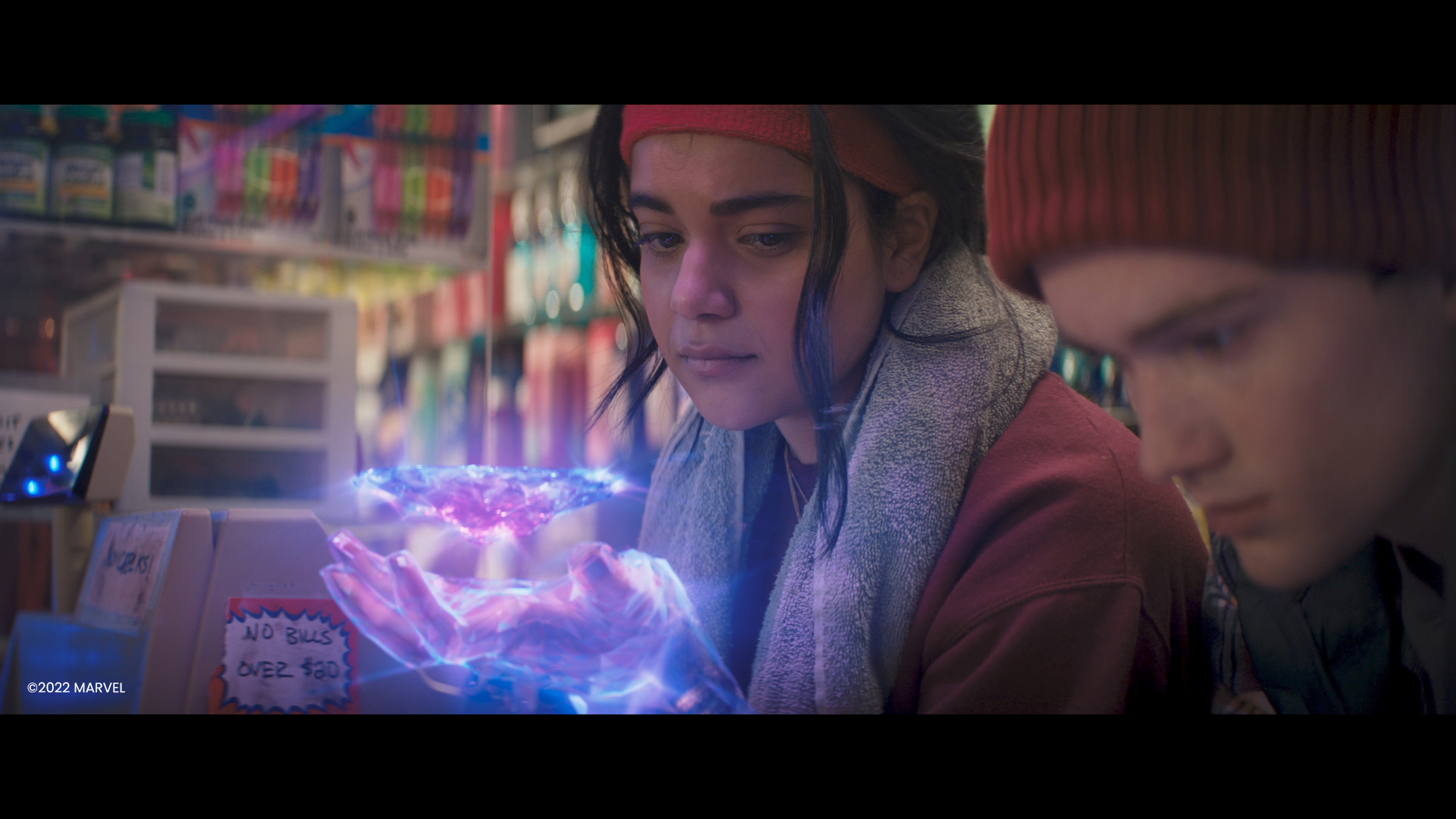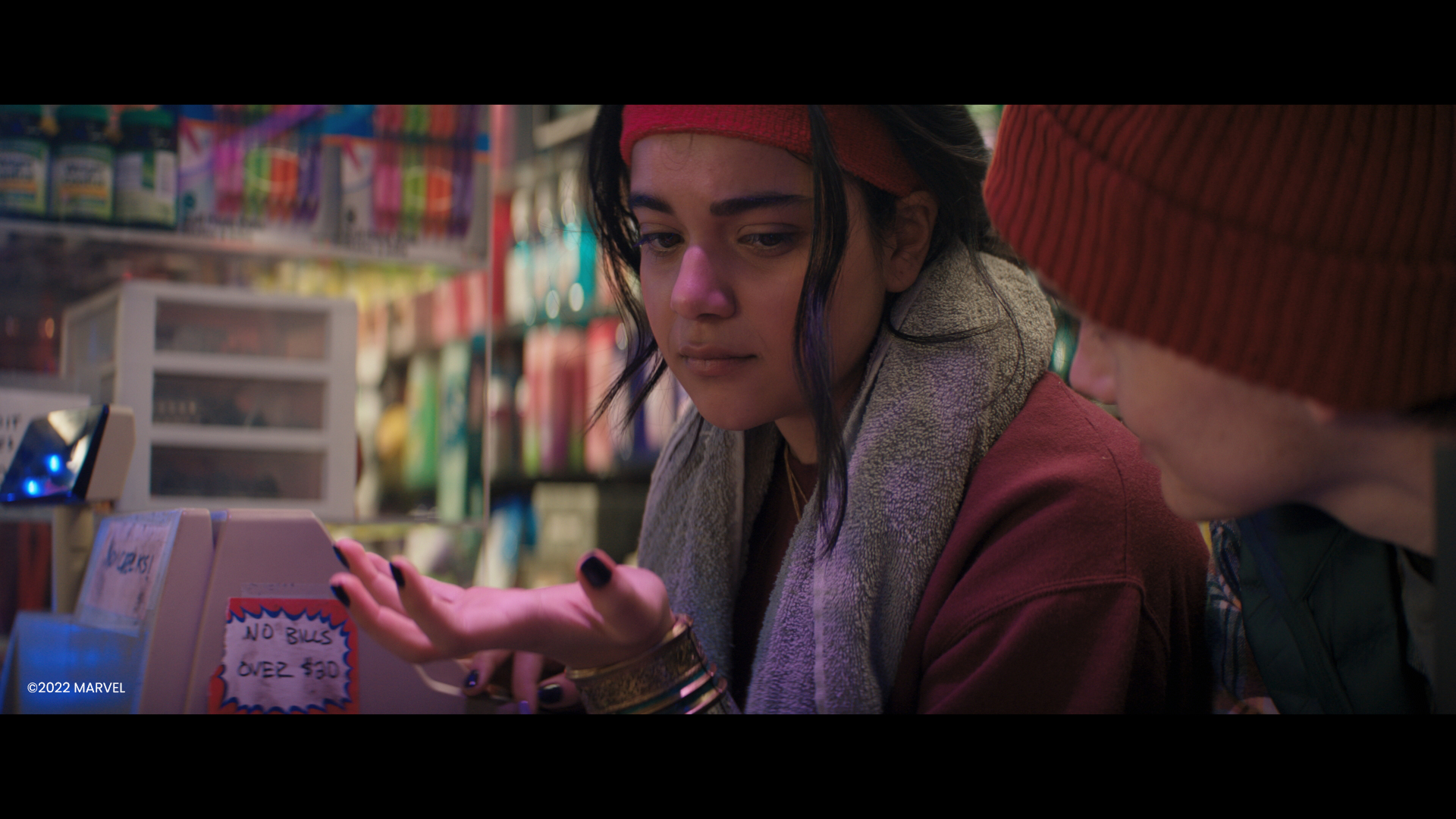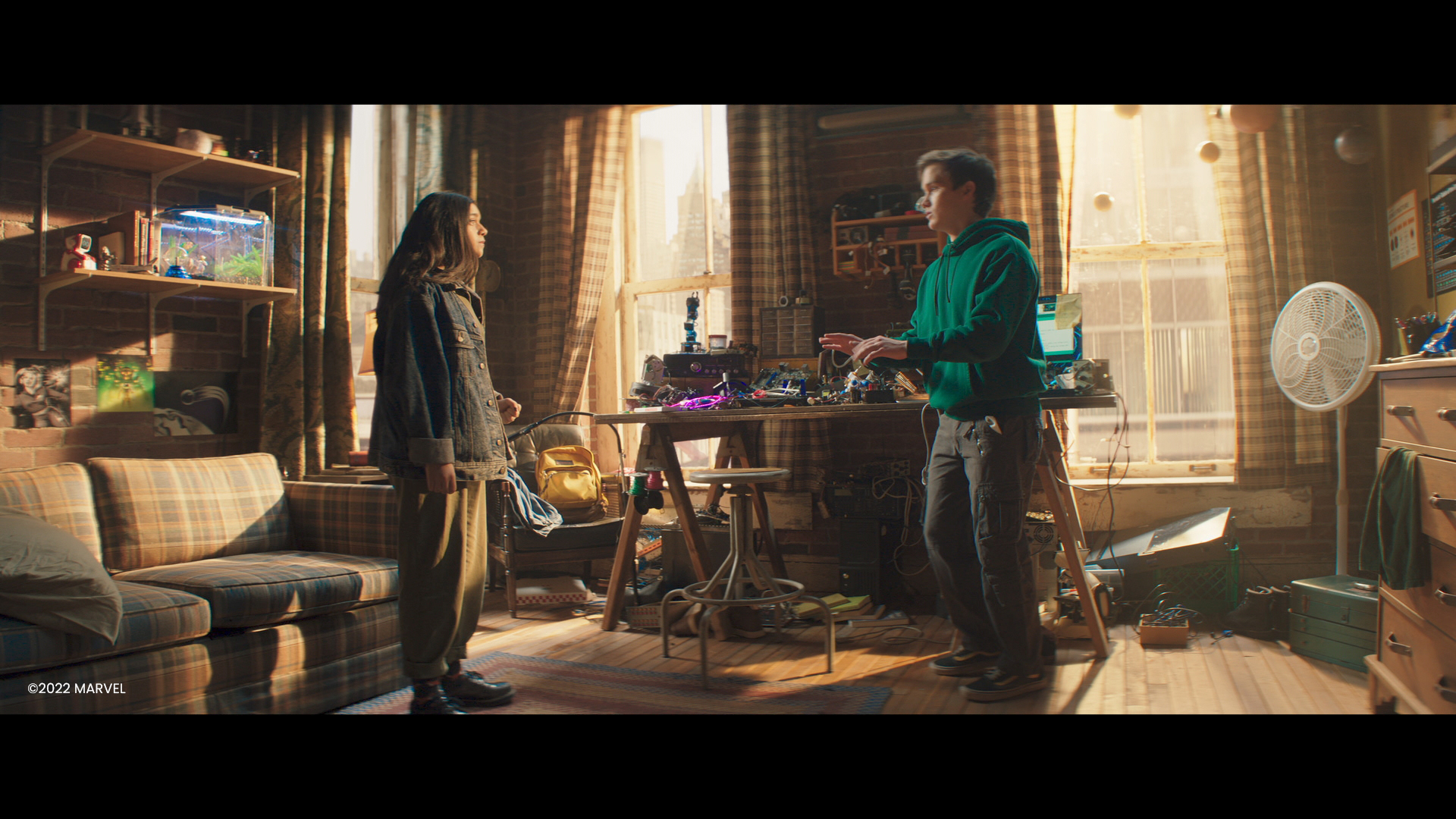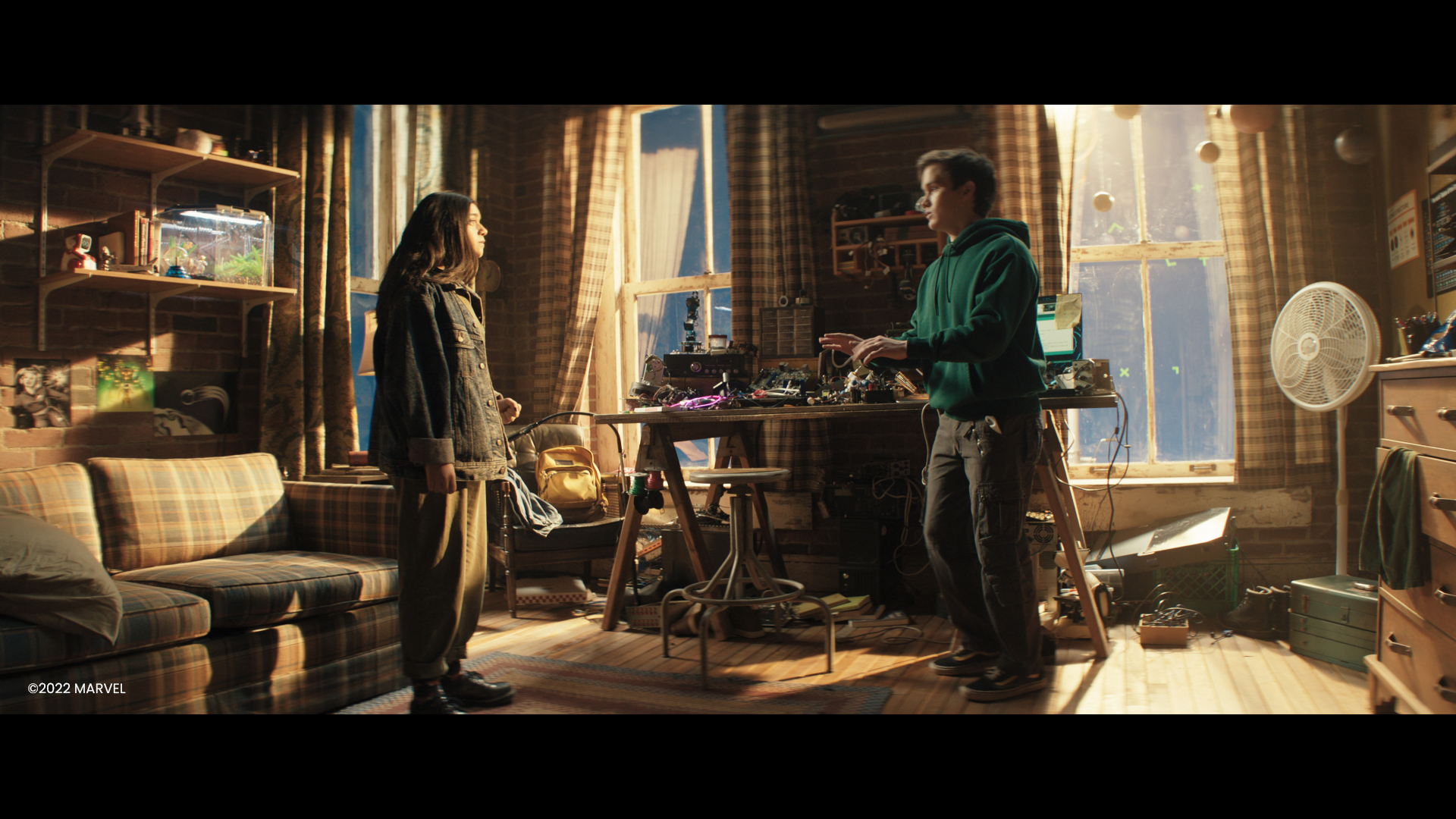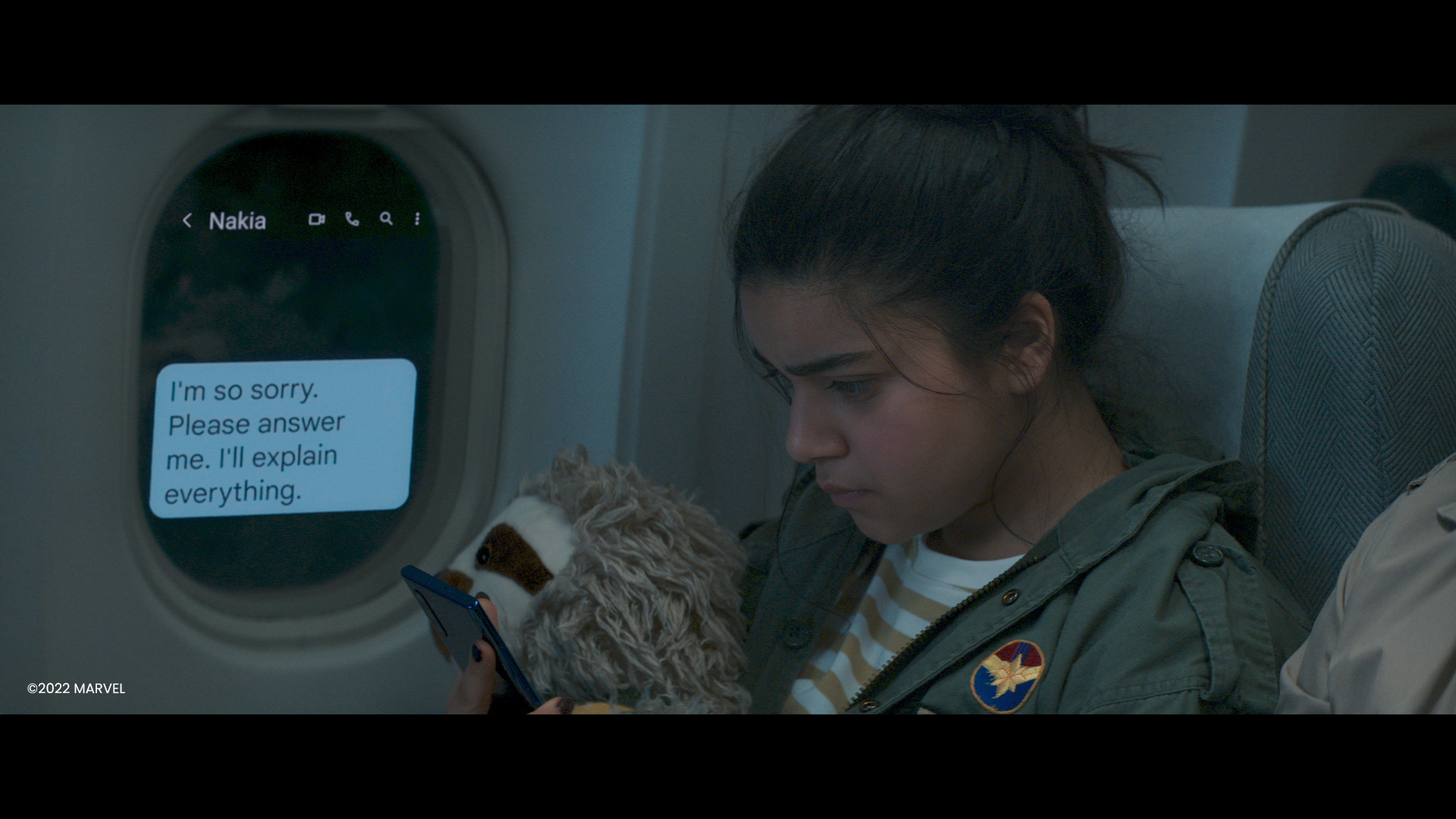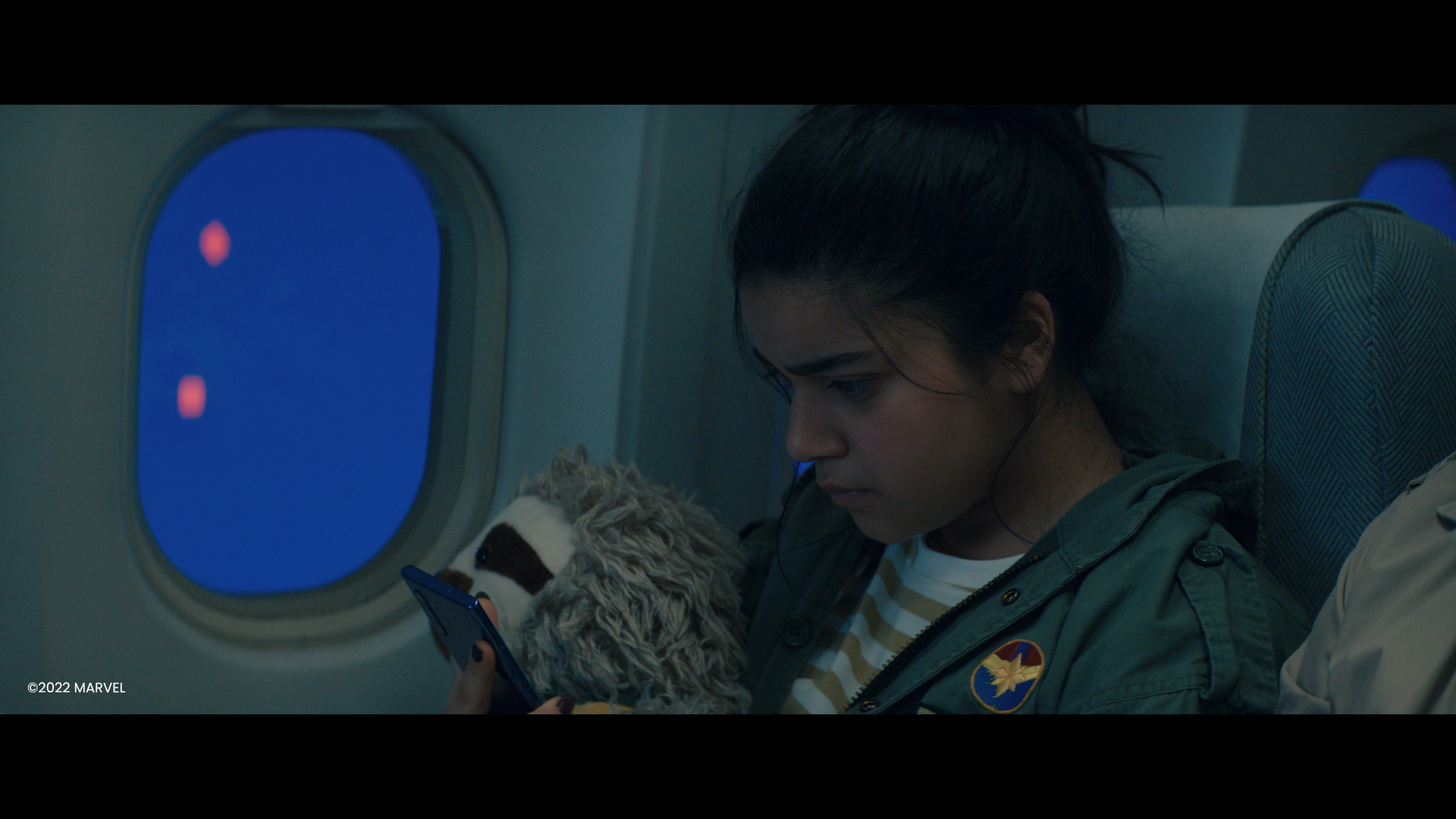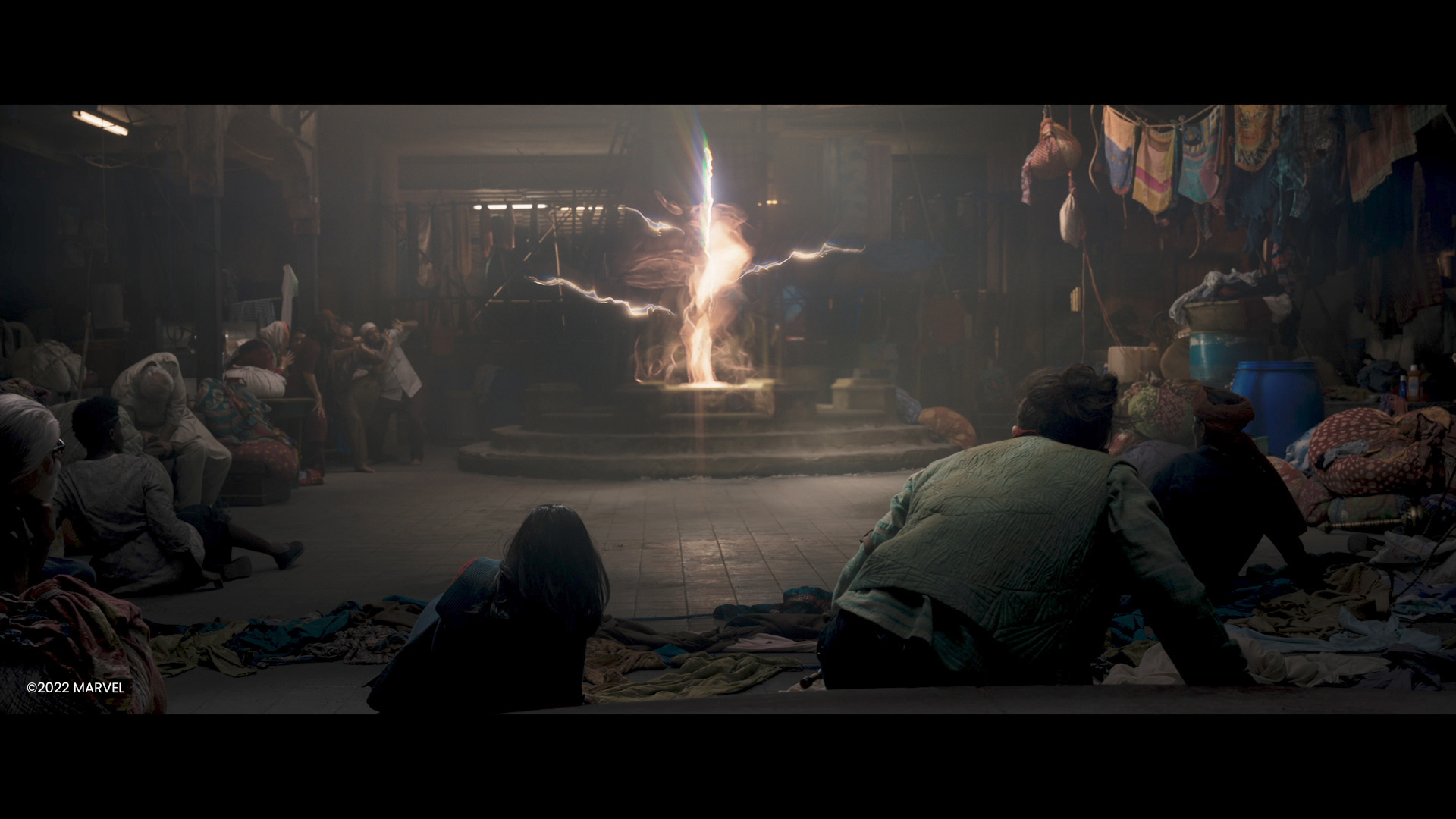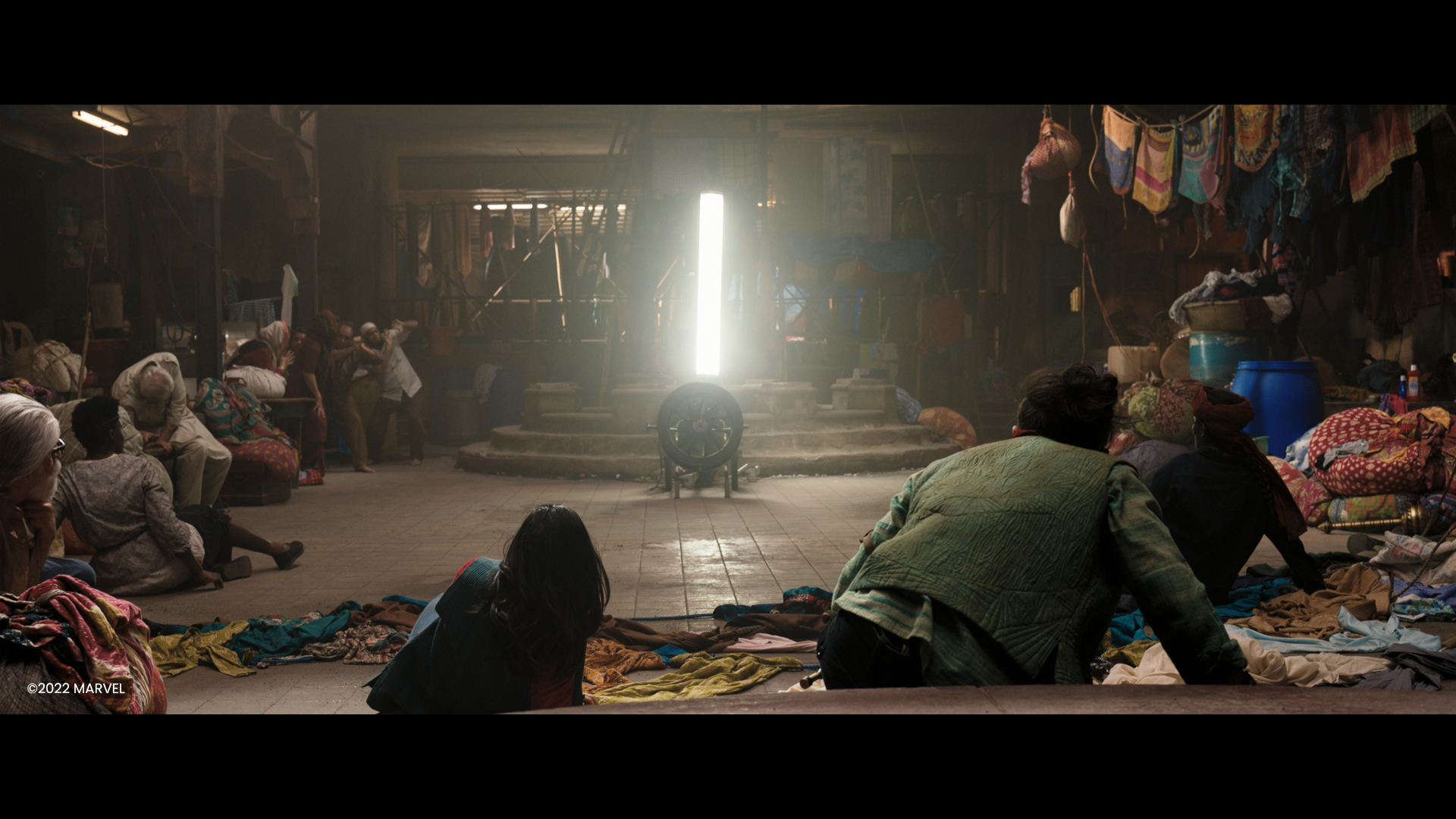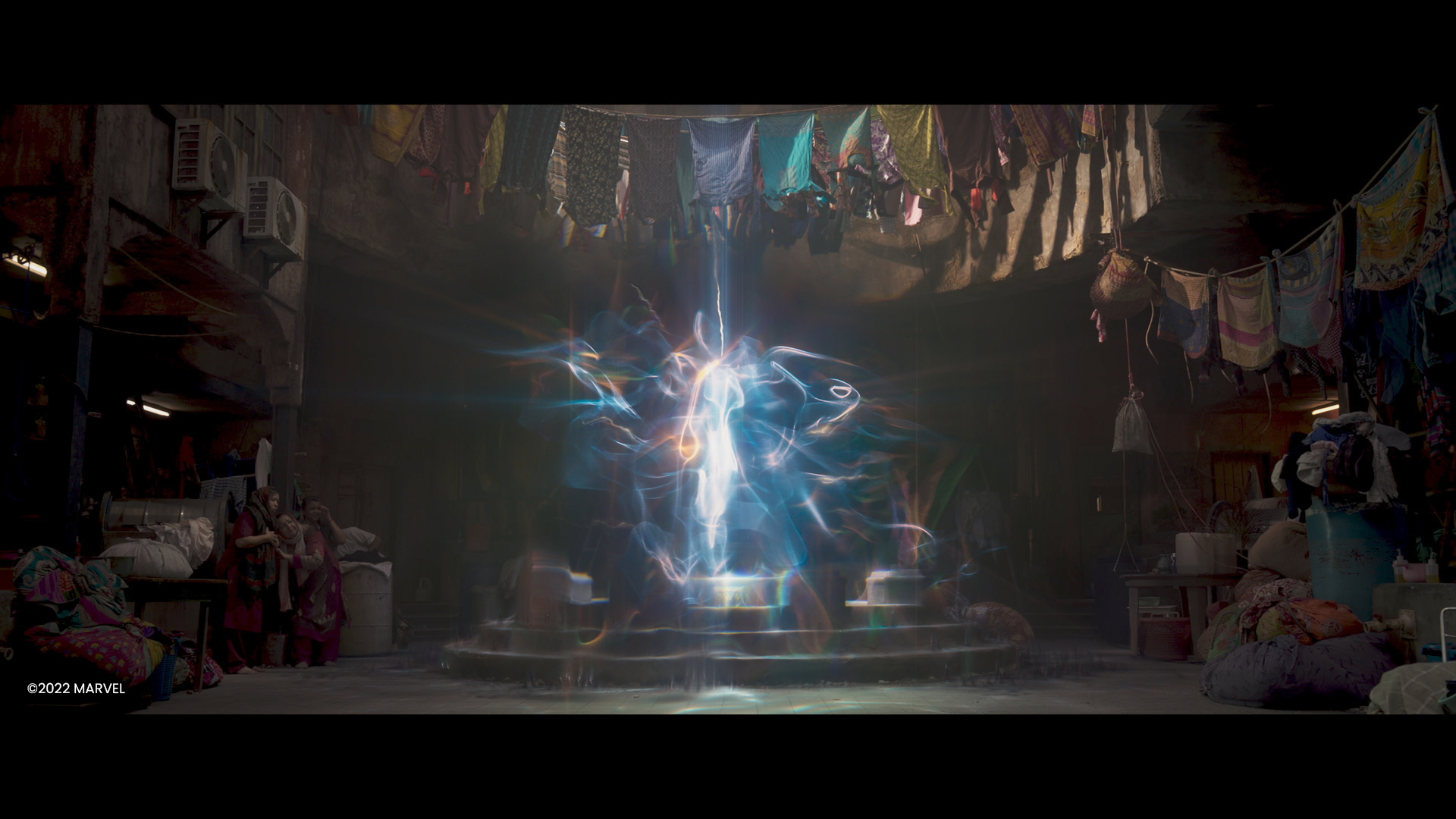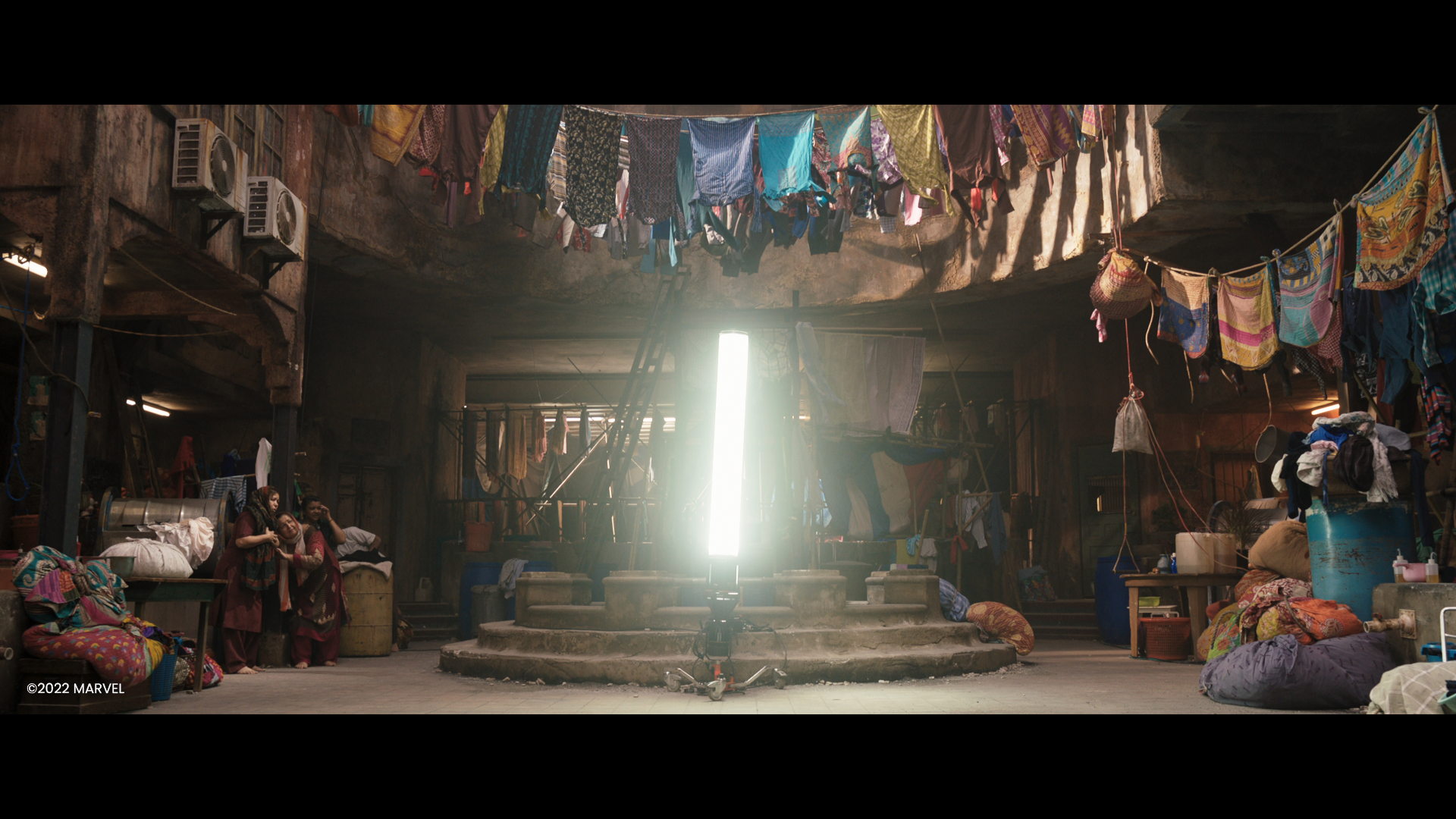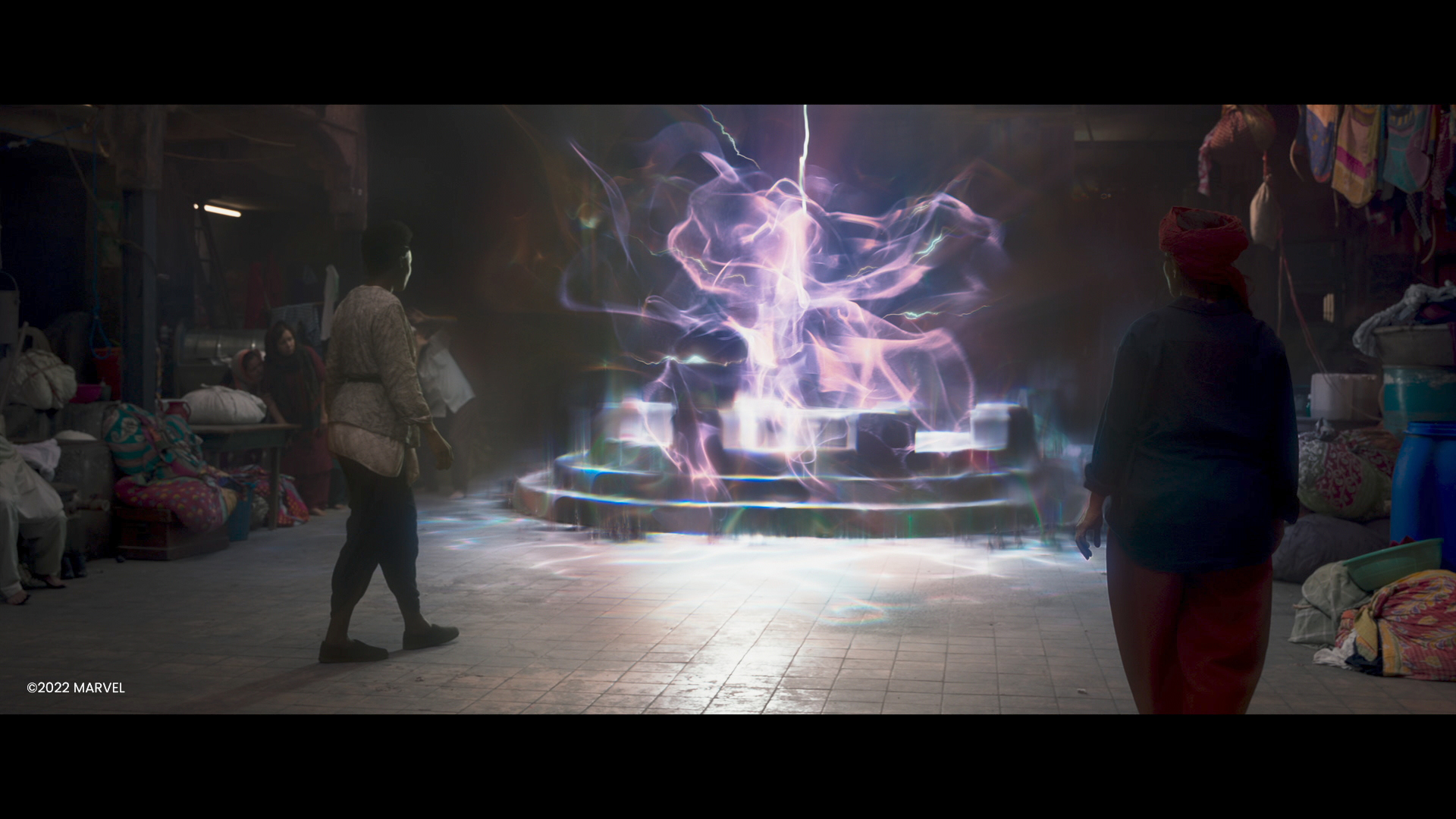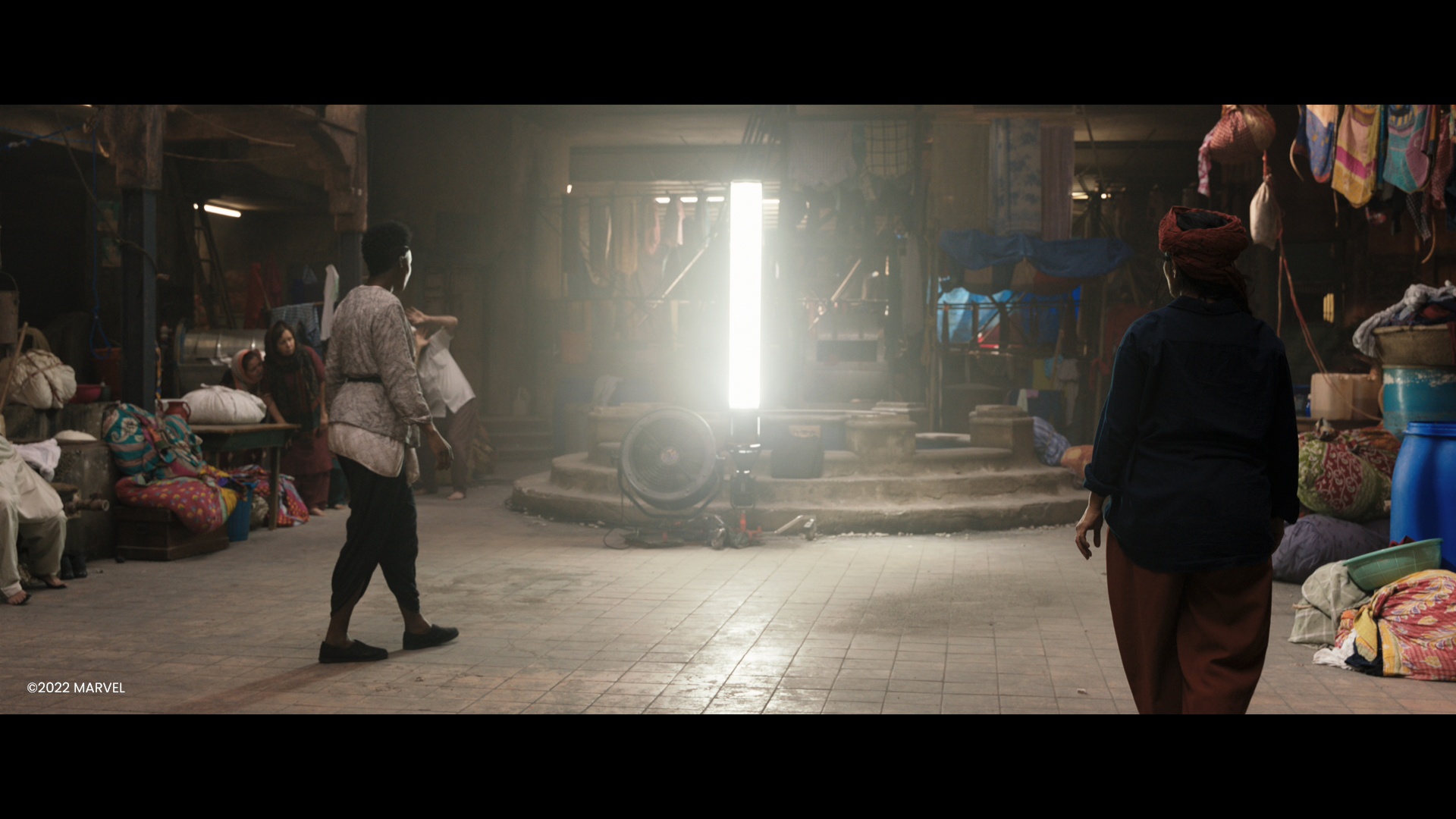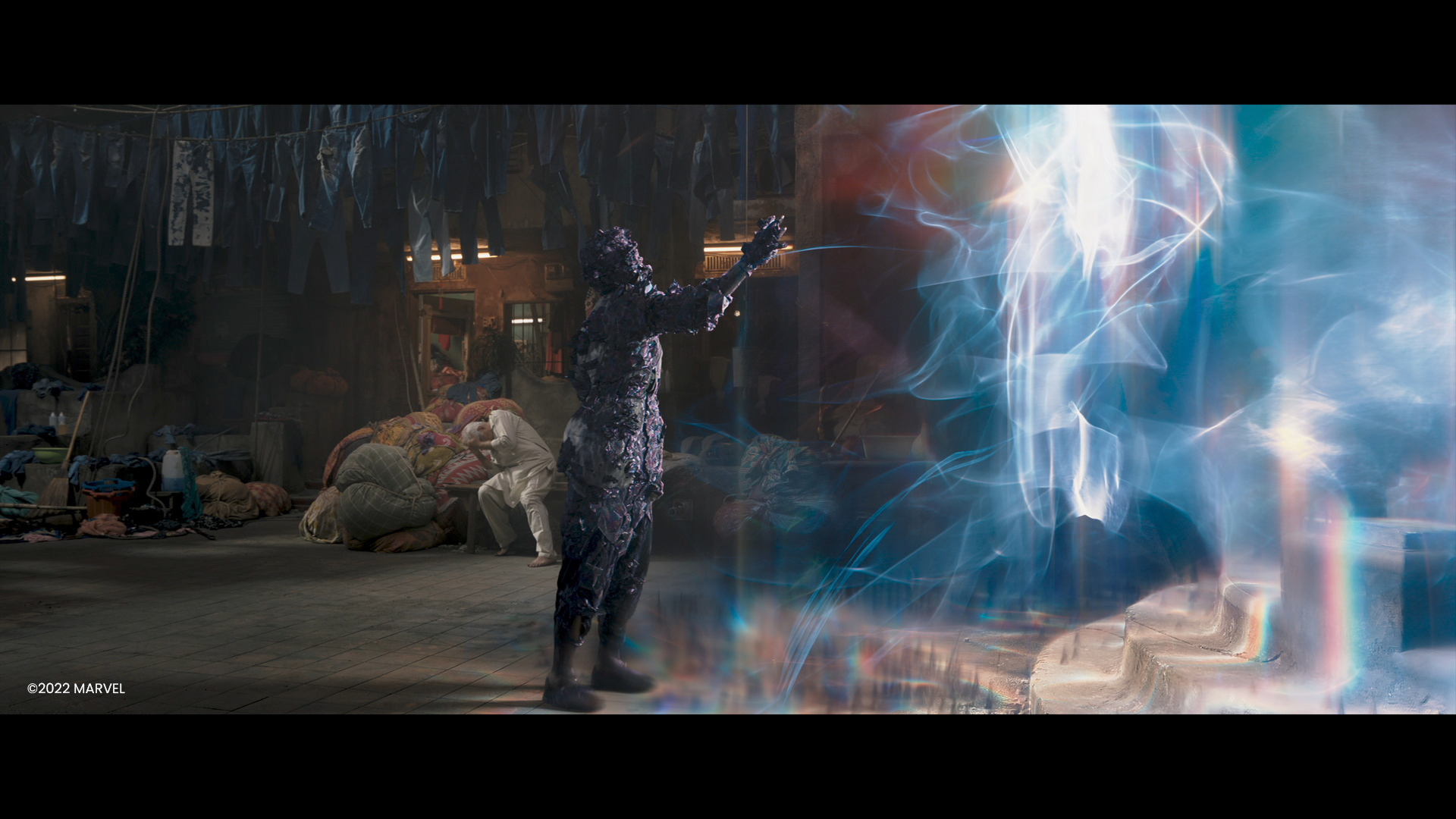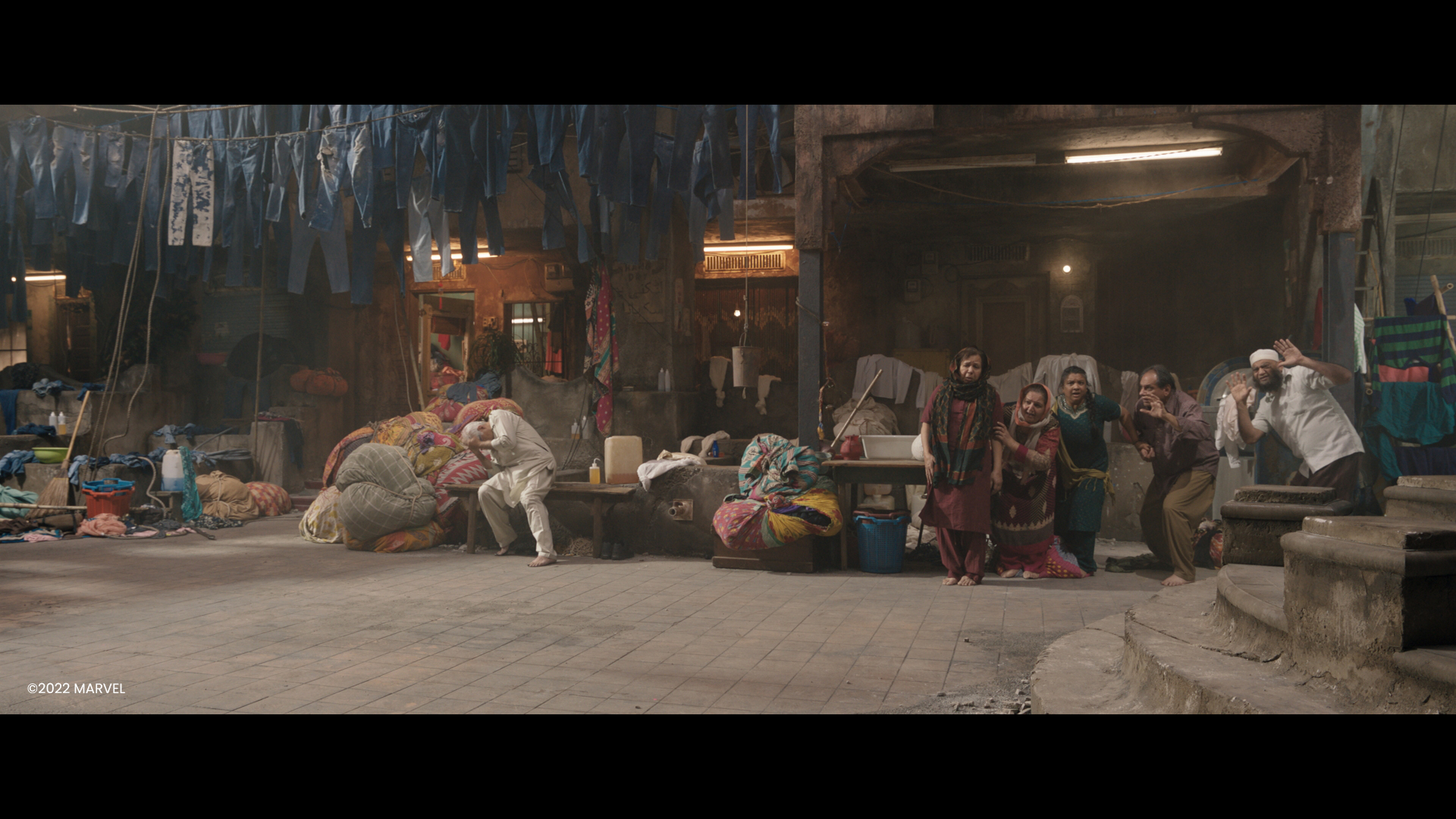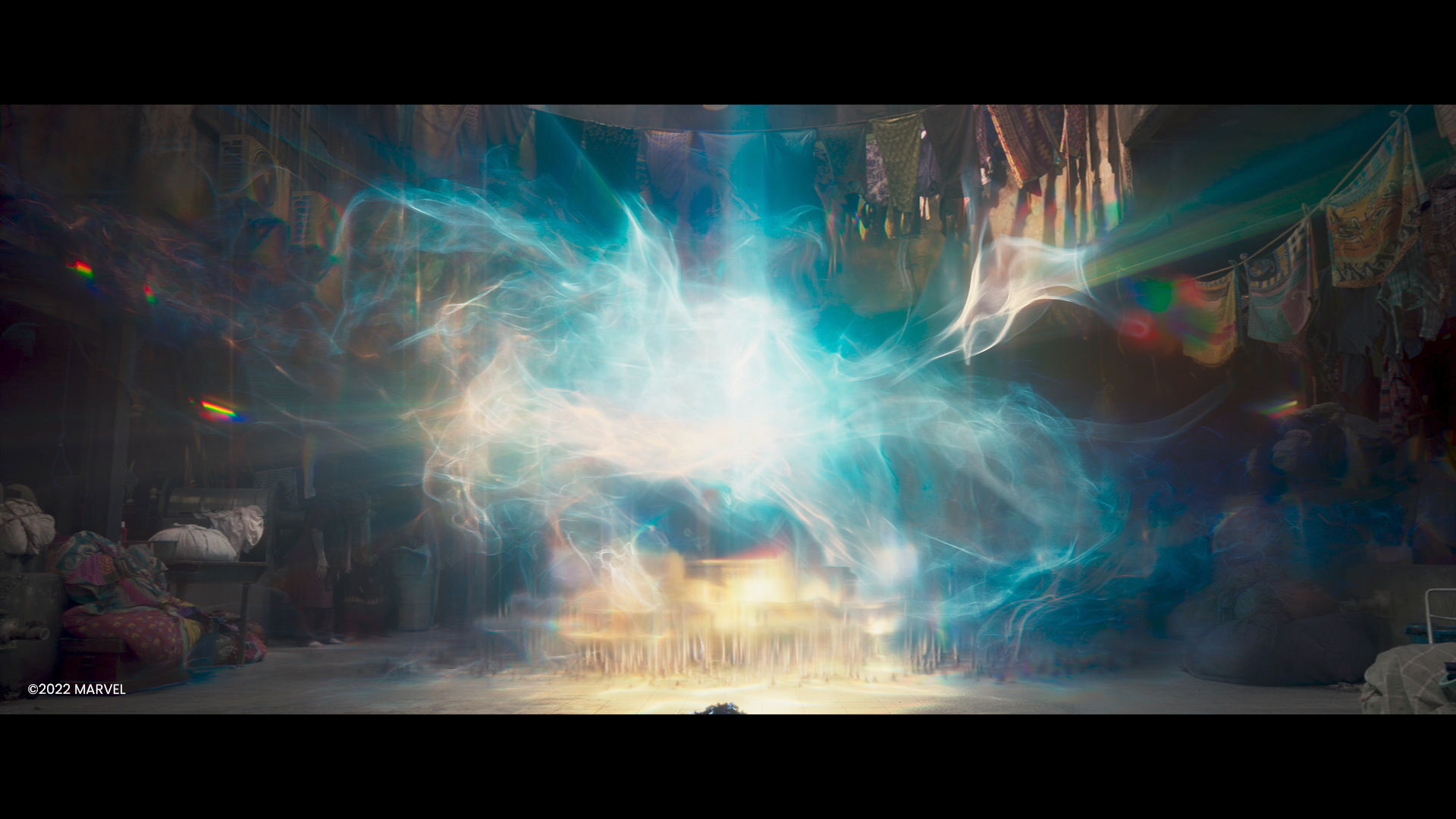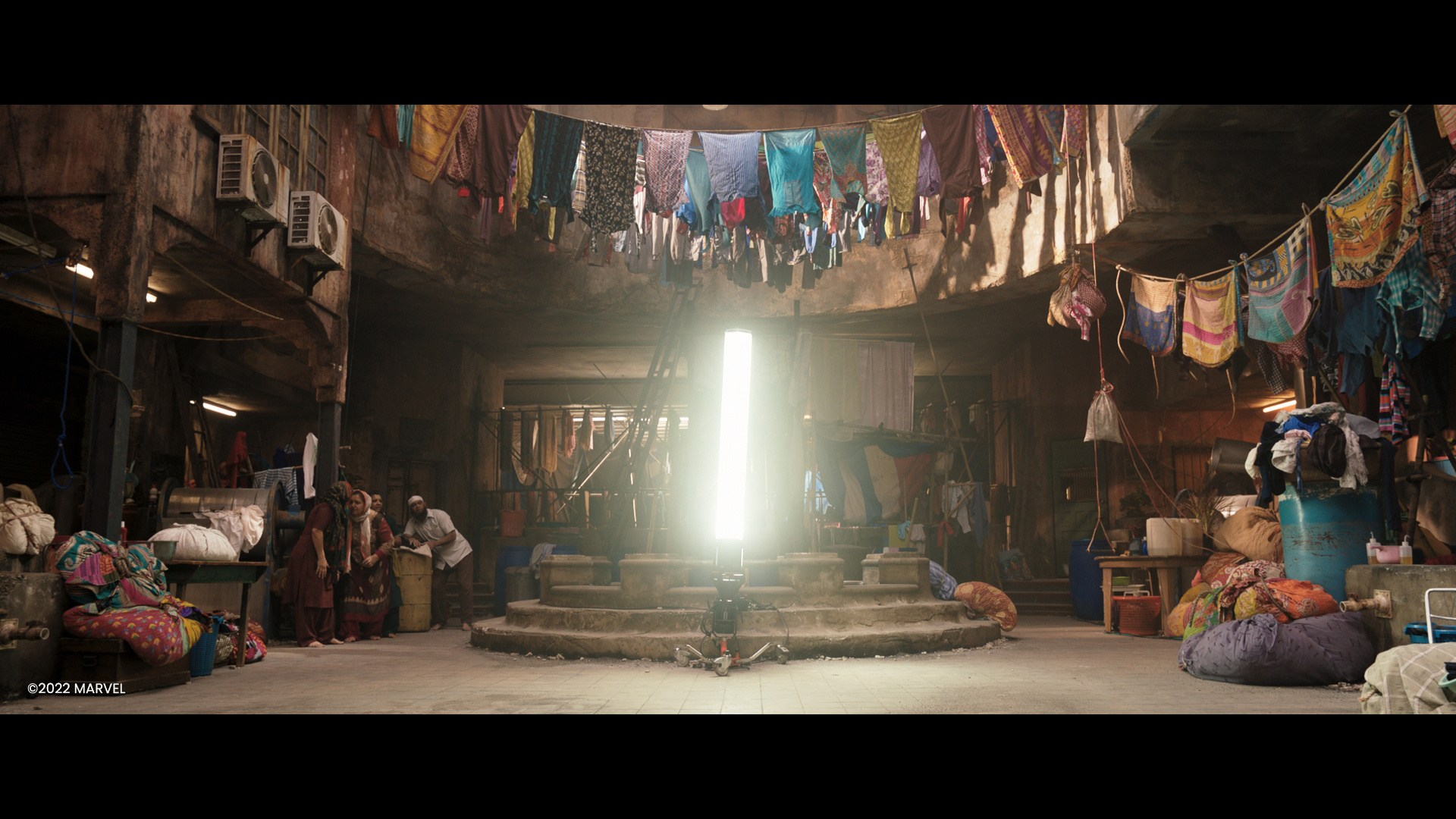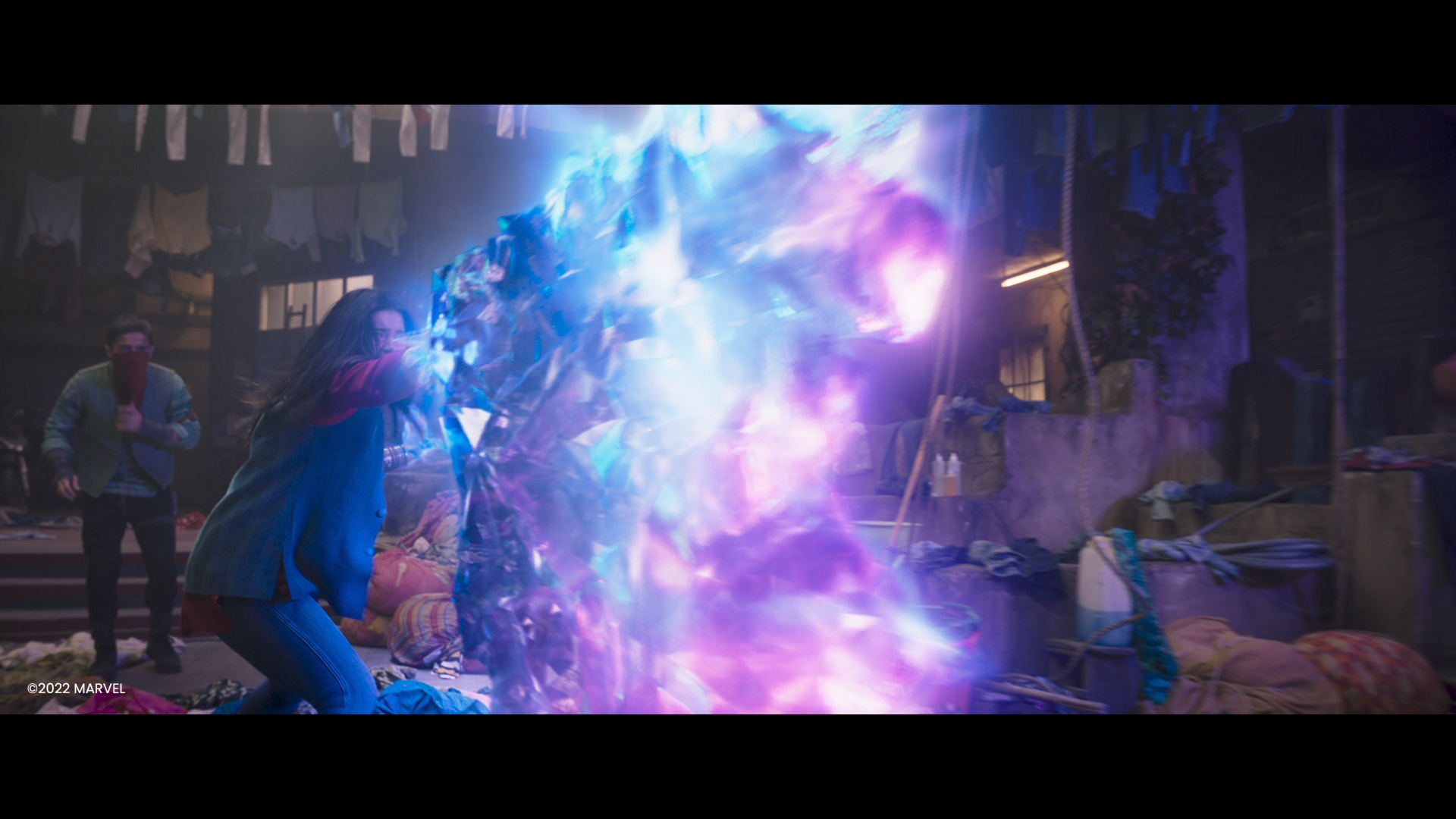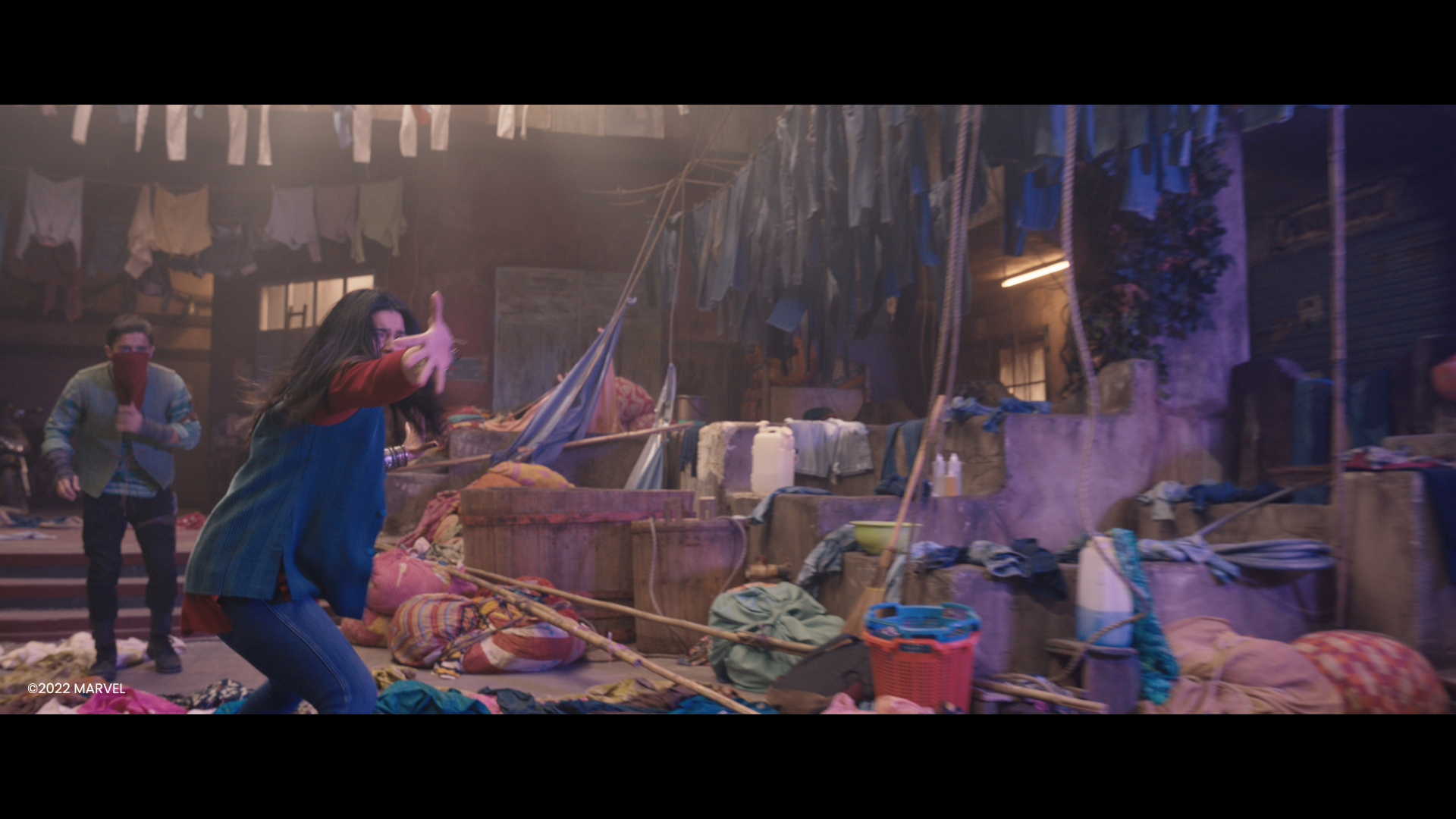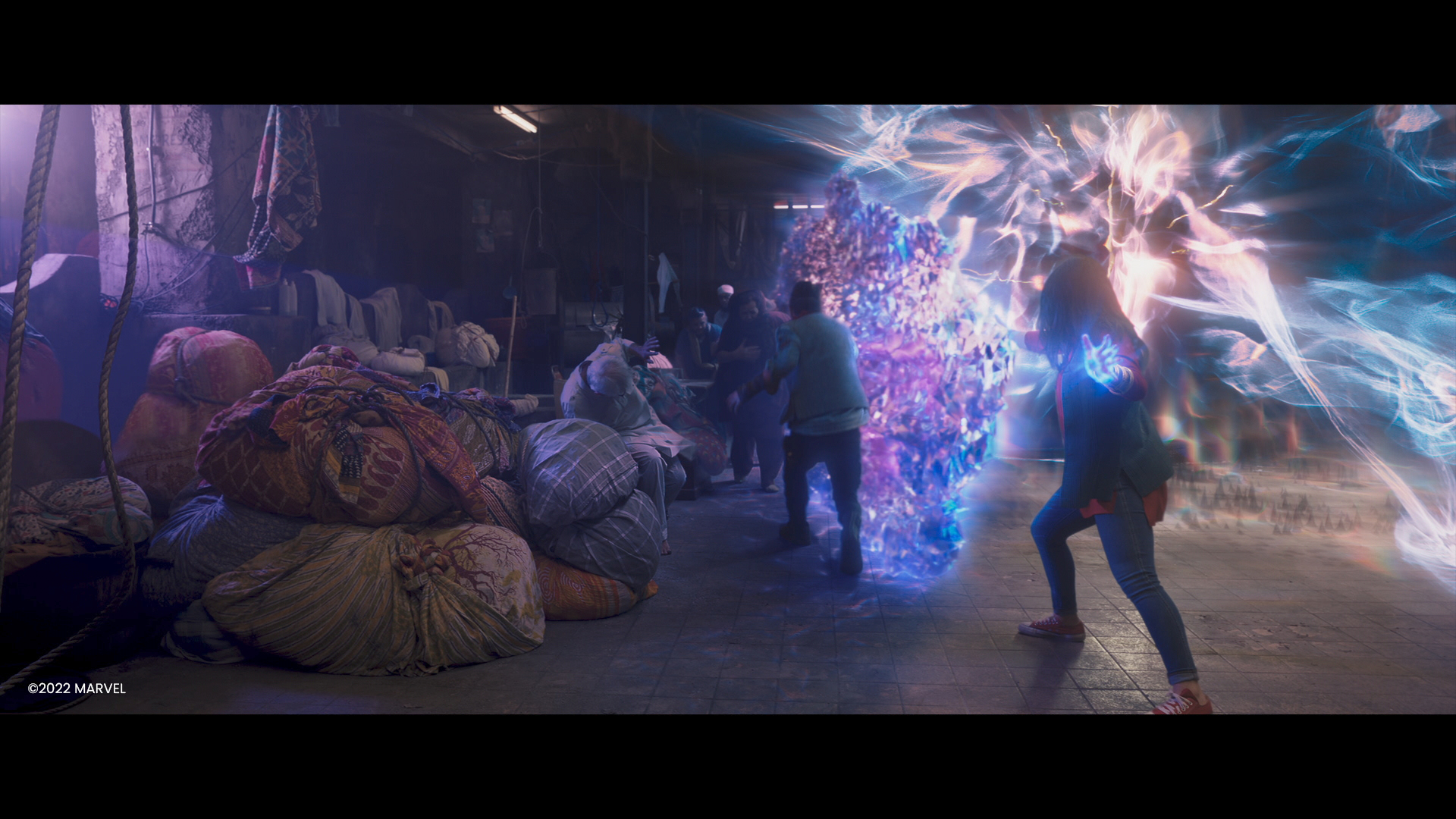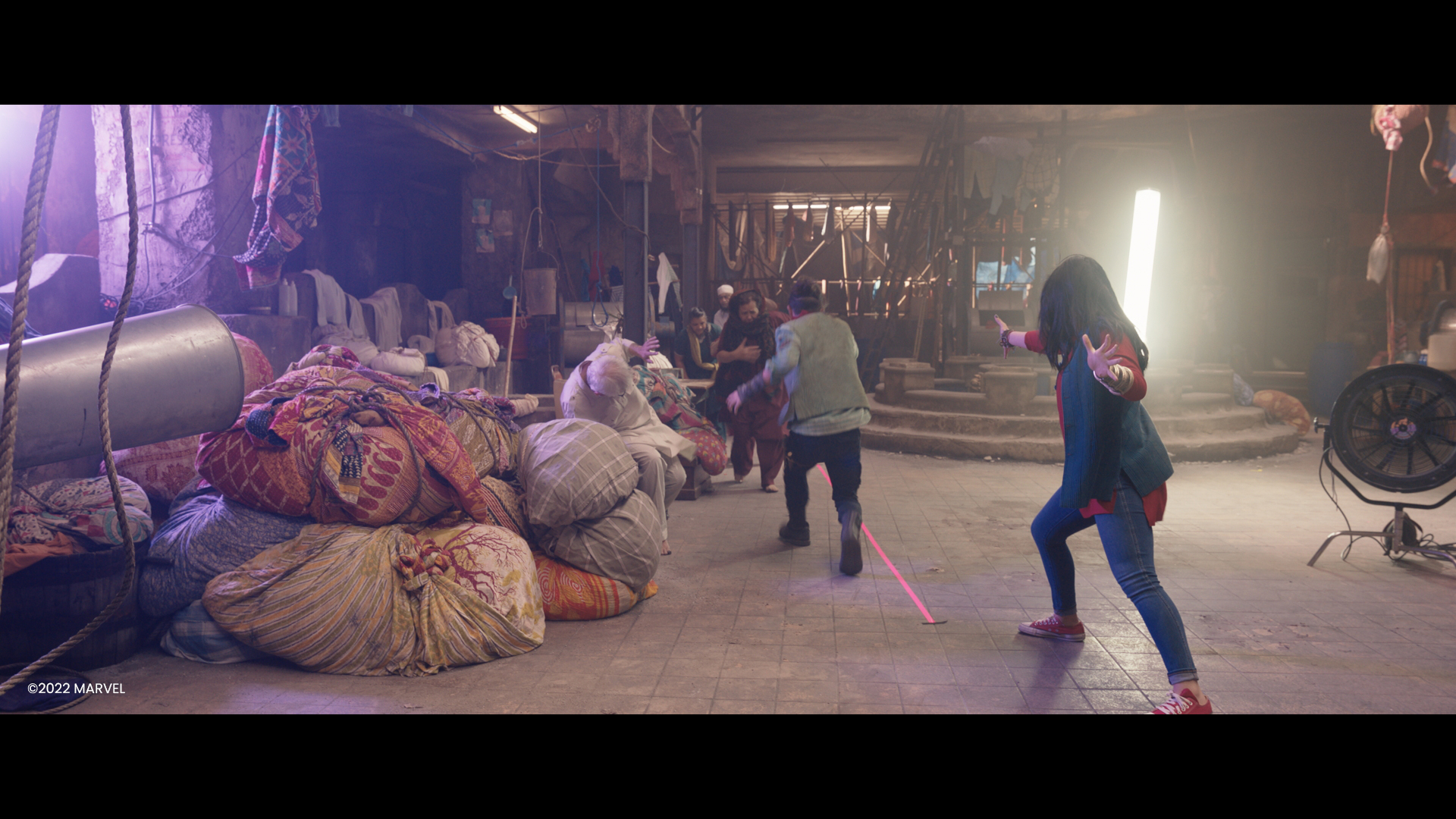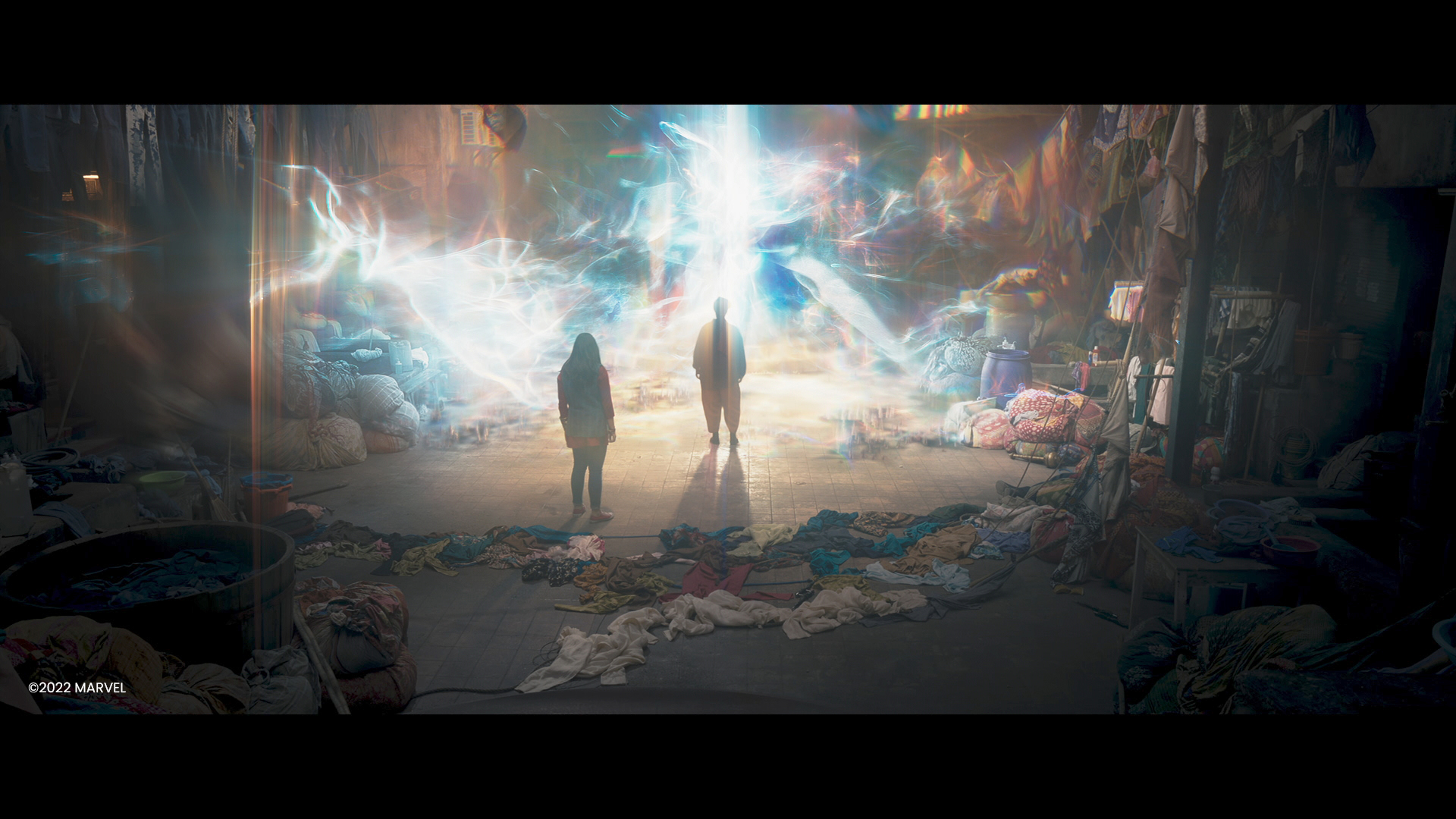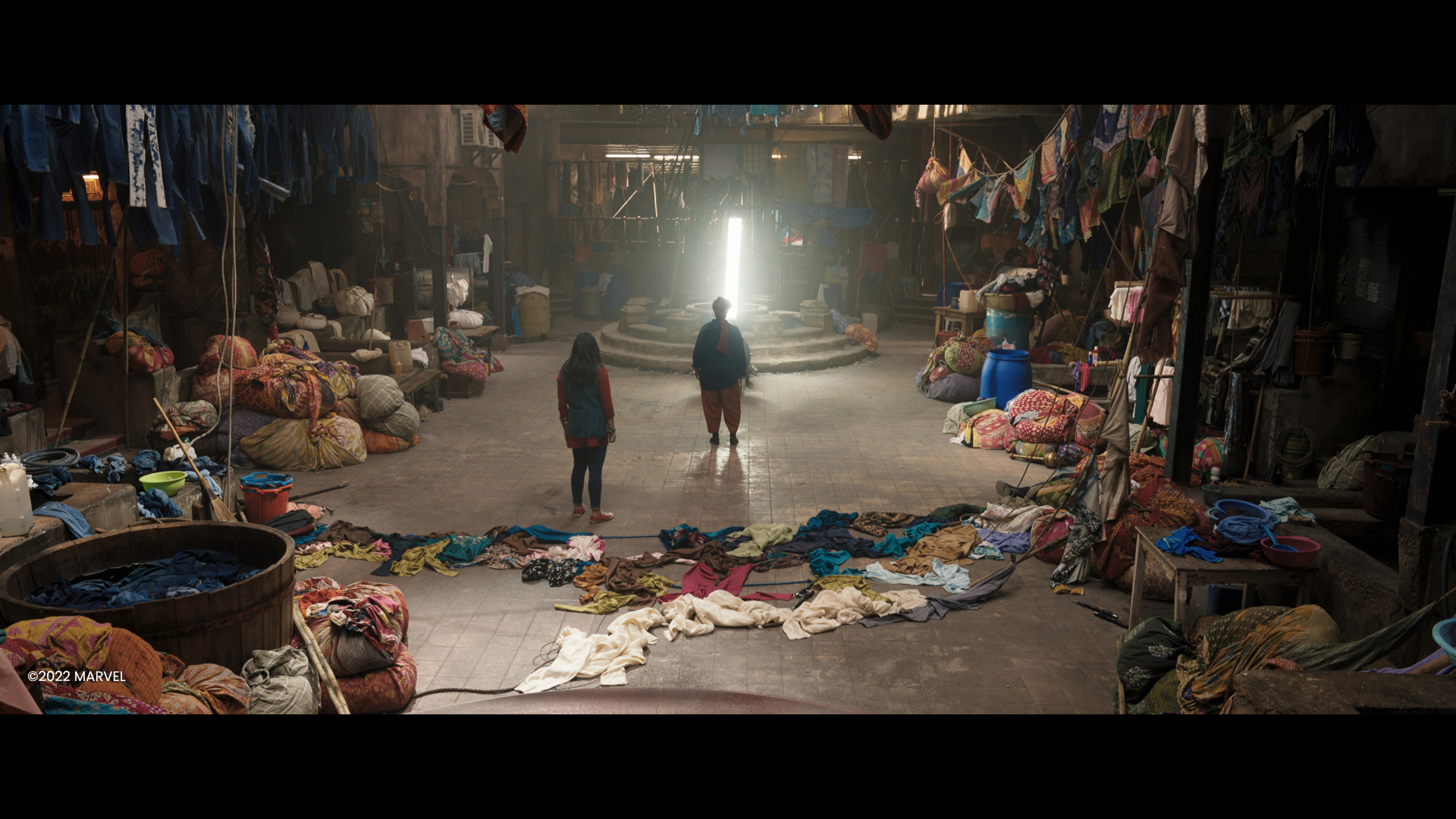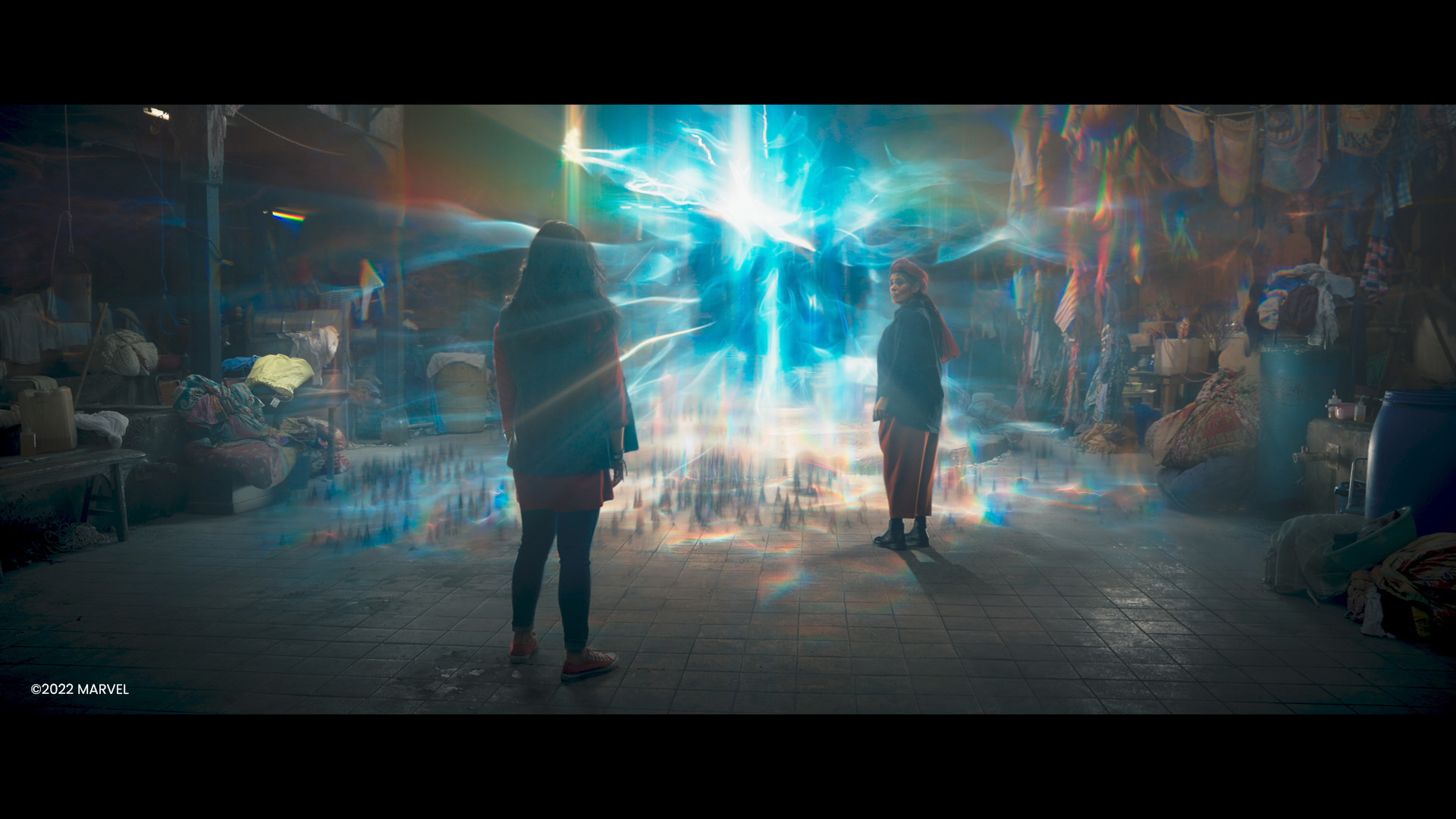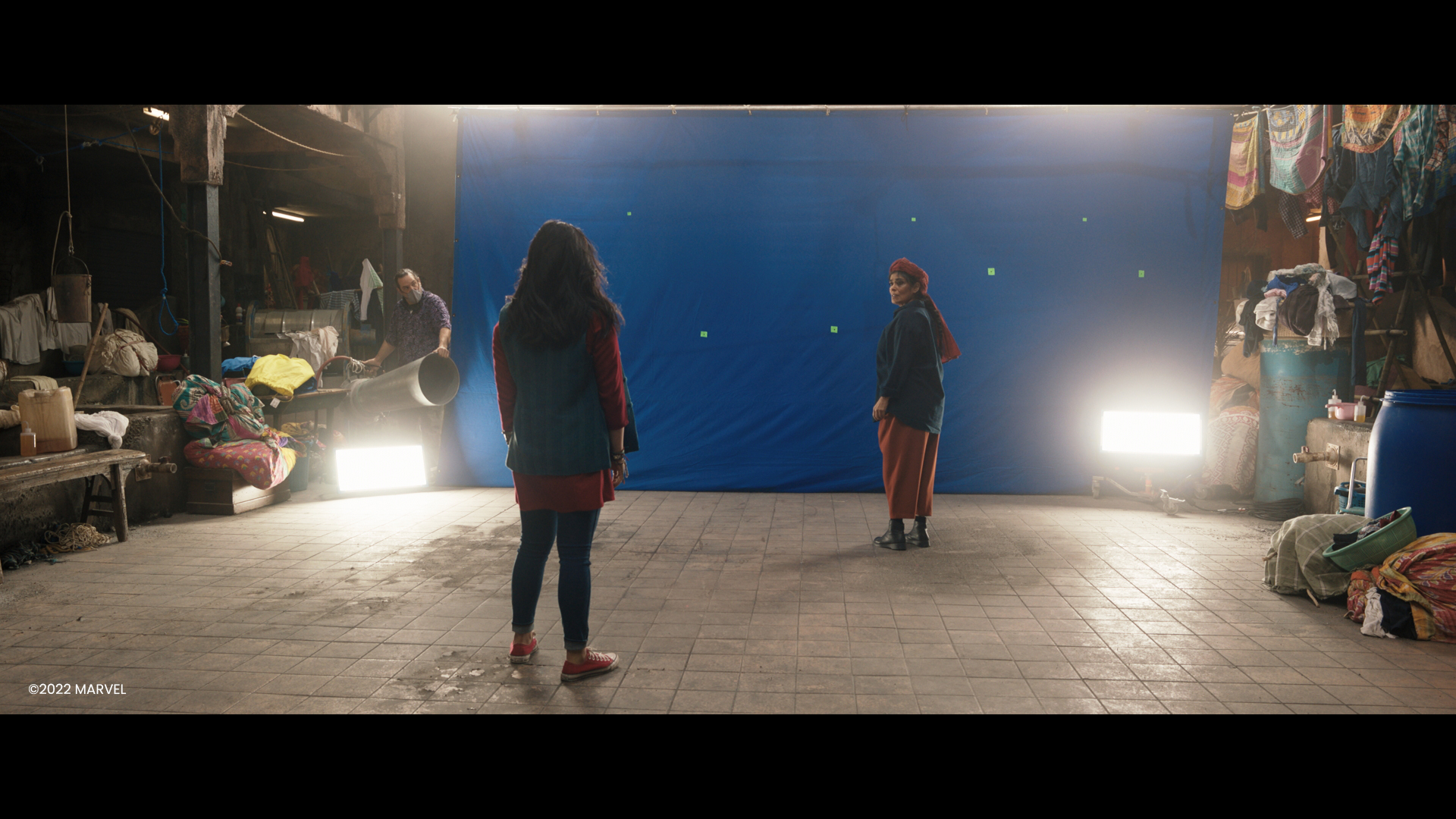
Interview: Talking ‘Ms. Marvel’ & Agents of S.H.I.E.L.D.’ VFX With Kevin Yuille Of FuseFX
I recently had the opportunity to sit down for a chat with Kevin Yuille of FuseFX, one of the companies responsible for the amazing visual effects work on the Disney+ MCU series ‘Ms. Marvel‘.
Marvel Studios’ ‘Ms. Marvel’ introduces Kamala Khan (Iman Vellani), a Muslim American teenager growing up in Jersey City. An avid gamer and a voracious fan-fiction scribe, Kamala is a Super Hero mega-fan with an oversized imagination – particularly when it comes to Captain Marvel. Yet Kamala feels like she doesn’t fit in at school and sometimes even at home – that is, until she gets superpowers like the heroes she’s always looked up to. Life gets better with superpowers, right?
Kevin, and the team at Fuse, were responsible for some of the major key shots on the series, such as the creation of “the veil” and some of Kamala’s “hard light” effects. They also worked on a number of smaller shots which you may have missed, so we get into that too.
Prior to ‘Ms. Marvel’, Kevin worked on all seasons of the wonderful ‘Agents Of SHIELD‘, so we also discuss the differences between working on a big streaming MCU show compared to a Marvel network series. Outside of Marvel, he worked on the Netflix superhero show ‘Raising Dion‘, which had its own complex VFX challenges. But before we get into the series, I started by asking Kevin how he came to work in VFX in the first place.
Geektown: Before we get into talking about ‘Ms. Marvel’, a little bit of background about you. What made you interested in the industry and how did you get into it in the first place?
Kevin: So I went to school, my undergraduate degree was actually architecture. That was many moons ago. I didn’t really pursue it. As soon as I graduated, it was kind of the dot-com era. I love the theory behind architecture and the design and the creation aspect, but then you hit reality, and it’s like, “Wow.” It takes the fun out of it, so I wasn’t really into it as a career.
I actually did go to San Francisco and did some web development myself for a little bit. My friends had started a couple of companies. So I did the dot-com thing. Also fell out of love with that pretty fast. Felt creatively stifling, and again, it felt more like work than something I really enjoyed. So, I went back to school. Originally it was for editing, but funny enough, there was a film class, I think it was a 16-millimetre film class, and one of the students put some visual effects in his little short, and I was like, “Wow, how did you do that?” And he just told me, he’s like, “Oh, I’m on the VFX track and this is compositing,” and this and that. So I switched almost immediately to the visual effects track.
I got an MFA in visual effects from the Academy of Art in San Francisco, a pretty big art school. And right after I graduated, I moved to LA and I almost got a job immediately. There may be a myth out there that it’s hard to break into the industry, maybe on the post-production side, but I don’t think it’s true. If you have a portfolio and a reel, even if it’s student work, if it’s good enough, you will get interviews and most likely you’ll start as a junior artist. So that’s what happened. I immediately fell into a company and started doing 3D conversions, and that was popular 10, 15 years ago. So that’s what I started as. And then I left that company and went and joined Fuse, coming up on 10 years. Holy cow, it might be almost 10 years to the day!
Geektown: Oh, wow.
Kevin: It was the end of August 2012. So we’re on my 10-year anniversary.
Geektown: Congratulations!
Kevin: Yeah. So it’s been forever. I’ve been at this company and it’s grown. FuseFX started as maybe 10, 15 artists when I started and now it’s just massive. Hundreds and hundreds of artists. So I’ve seen it grow and through the years I’ve again, started somewhat junior to mid-level compositor, and I moved all the way up through compositing sup and the effects sup, and now I’m a visual effects sup for episodic shows. And I still like to composite and be on the box and stuff. So I tend to still dial in looks and all that stuff, the fun stuff. So that’s a long answer to the journey.
Geektown: It’s funny, the number of people that seem to get into architecture and then drift away from it when they find themselves designing layouts for fitting air conditioner units or something.
Kevin: It’s just not as glamorous as when, “Oh, I’m a student. I could design anything I want!” [Laughs]
Geektown: I remember talking to a production designer who trained in architecture who was like, “Oh, this is great! I can build things and they don’t have to stay up for very long!” [Laughs]
Kevin: [Laughs] Yeah. Yeah.
Geektown: So you’re working now at FuseFx, and their catalogue is ridiculous in terms of just the breadth of shows that they’ve worked on.
Kevin: Yeah, it’s a lot!
Geektown: One of those is ‘Ms. Marvel’, which is a wonderful series. Really enjoyed that show, it was such good fun. As with a lot of these big Marvel series, Fuse aren’t the only VFX company working on it, so what were Fuse responsible for in terms of the VFX?
Kevin: So ‘Ms. Marvel’… I don’t want to get the facts wrong… but I’ll just say that they were in production for a long time before we joined the show. There was COVID and all that happened. I don’t know how many months they were in production, but it was a long time, I want to say over a year. But we picked up towards the end of the post-production of the show. They had some reshoots and some vendors scheduling they had to roll off the show, so we picked up the slack where some of these other vendors just couldn’t do the work.
It was a lot of work for us and a pretty compressed schedule, so it was daunting. But basically, we had a few sequences early on in the season where it was your more traditional blue screens, and set extensions. There were some sequences in Bruno’s apartment and in Kamala’s room, all those windows and stuff, we did a few scenes there. Very straightforward stuff, nothing crazy. There was an aeroplane scene where we go in, pull out from the outside through a window and then we’re inside the aeroplane. And then the same thing, we fly out of the window to show Karachi. But that was the first more just traditional stuff, just run-of-the-mill effects.

The big thing was we had to do some Hard Light. The Hard Light is her power. It’s light that’s kind of in crystal form and it has all these rays that come off, but we call them the light leaks. Those had been established again by multiple vendors. Lots of vendors were working on it. Even our sister company, Folks VFX in Montreal, was working on the show. They did a lot of these Hard Light shots. So we had a few of those. So it’s not as simple as, “Oh, here’s a setup from so-and-so. Just make it work.” It’s a pretty complicated setup. It requires somebody who’s pretty good at Houdini [3D animation software], the programme we use for effects, to reverse engineer what others have done. Our setup was pretty procedural, so it could take on any shape. We did a wall in this big scene.
When we had to do this wall, she has projectiles. So that was the Hard Light and the big effect that we were asked to do was the veil in episode five. That was a pretty challenging sequence. When it was presented to us, again other vendors had started look development [the pre-production phase where a show’s overall artistic & scene styles are established] on it, but Marvel hadn’t signed off on anything, so it was still pretty open and it was kind of a nebulous idea. What is that pours out of a rift? What does that look like? The earlier versions, it was almost like a fire and they didn’t want it to look something terrestrial, something that looked like fire, something that the audience would be able to identify. So we had to push something a little more ethereal, like a flowing fabric, yet it still had qualities of… I don’t want to say a fire, but a fluid.

So imagine light pouring out of a hole and then we had to add a bunch of just bells and whistles to it like chromatic aberrations and these pulses. So it got a little scary because again, we showed up at the end of the post and we had to evolve the look, multiple looks for it. We had to figure out what the veil does to the environment. Again, we had to lean more heavily on comp 2D versus 3D for some of these things, because there just wasn’t time. So you have to do what you can to tell the story that this thing is coming out, it’s affecting the environment. But it’s also like you’re looking at your watch, you’re like, “Okay, there’s no time.” So yeah, it was just finding the look that satisfied the writers and the director and the Marvel executives, but then there was some compromising. They did realise that we were up against it, so not everything that they asked for we were able to achieve just because of time. But that was the massive sequence that our team did for the season.
Geektown: Right. Yeah. And that was an incredibly key sequence as well. To come in at the end and then be handed the thing that they’d been building to throughout the entire show.
Kevin: And then you watch it like, “Wow, that was really fast.” And then I know there were criticisms about that episode from a storytelling perspective, I was like, “Oh, wow. All that work just went by in two minutes.” But I think there was a lot that they had to get through in that episode. But at the end of the day, very proud of what we were able to pull off given our restrictions, time and schedule and all that.
Geektown: Yeah. It’s a really good sequence. I think it works incredibly well. One of the things you were mentioning there about the Hard Light side of things. So, your team weren’t the ones that established the look of that because as you say, other vendors had been working on it before then. But that big wall was really a new power for Kamala.
Kevin: Yeah. So the original setup, there were some established geometries, she could make platforms, she has this armour, her hands, this and that, when she envisions the big hand that punches. All those were kind of pre-made assets for us to work with, but we realised that because we had some unique shapes that we had to do, we just had to redo the setup ourselves. So we went with a more procedural approach. I’m not an FX artist. If I named it, Ashkan Azarmi was the wizard behind redoing the Hard Light set up and it was all procedural. So it’s like, oh you want a wall? So you can create a base geometry that’s a wall, but then it’s able to facet, you can facet it, you could control the number of size of the facets.
There was some refraction gags of the complexity, the crystal inside the wall he was able to control. So all of this was done in Houdini. Then so all these crystals that animate on are rendered as multiple passes for the compositor. And then that’s where we kind of dial in how much of the blue versus pink in the centre, how much do we see through it, how reflective and all of the highlights from the environment, how much do we mix those in? So there’s a lot of rebalancing and calm. And then there are the light effects on top of that, which again, there are previous setups.
We opted to redo them for the light leaks. And that in itself was… it’s crazy math of these guys do, I can’t even explain it, but he was doing it! He had something to do with motion blur and velocity particles. I can’t even explain it, but he was able to focus the light into those phasing beams. So again, that was also out of effects that he would get renders and down and stuff like that. Then that wall grows on, unique to the show, so it was a good thing that we had a more procedural setup at that point and yet it went really smoothly. The Hard Light by the end was a pretty smooth process. Other artists could pick up the setup and do their own things. But yeah, it was by the end. The Hard Light was pretty solid.

Geektown: It’s one of those things that had a great end result, but to me, as a layperson, the Hard Light seems hellish complex to deal with. It’s kind of see-through with multiple colours, reflections, light bouncing off it it all over the place…
Kevin: Yeah, and thank thankfully we weren’t the first vendor to go through that process. Marvel’s particular and there are in these look-dev, we’ve had to do that for ‘Loki’, we had some stuff we had to look-dev and it takes time. There are a lot of people who have ideas and stuff, so it does take time to develop a look. So when we got the Hard Light, it was established, so there were already rules that we had to follow. So it was easier for us to push through the Hard Light shots than I would assume some of the earlier vendors. But because it was established, the VFX supervisors on the client side, Sandra and Sandro [Blattner], “the Sands”, They knew exactly what the look should be, so they would get very specific notes and then it was just our job to match them. But yeah, I think it was a pretty elaborate setup. I can’t remember off the top of my head how many passes there were, but there were a lot of renders!
Geektown: I can imagine there would be! You mentioned earlier some of the more traditional effects, which always fascinates me. That’s the thing with this sort of show. There are obvious effects in it, which look great and look cool, but there’s all the other stuff, which the audience doesn’t see. Were there any bits and pieces which people might not have spotted as an effect which you ended up doing?
Kevin: Oh, yeah. In episode one, again it’s not going in anyone’s reel, but there’s a conversation that she’s having with her student counsellor. They’re in his office and they’re having a conversation and we’re kind of just getting to know her and her personality and all she’s doing is sitting in a chair and it’s a back and forth. But what people don’t realise is half of the time the original shots, the lamp behind her, was off to the left. The continuity. Half the shots, the lamp is behind her head, the other half they were not behind her head. So we had to move the lamp to be behind her head.
And I got to be honest, I probably can’t even tell watching which ones we actually moved the lamp. It’s roto. You need a lot of roto, when you extract something out of the plate, create a matte and so you’re rotoing individual hairs and stuff. It gets to be pretty tedious work. I didn’t have to do it, but she got a lot of hair and it’s got some frizziness, and you’ve got to make sure you put that back in front of the lamp. So I would say that was probably one that no one would’ve caught.
Also, anything with a window, I think these days people assume it was probably a blue screen. There’s some paint-out stuff, rig removals, getting rid of wires and things like that. That’s pretty invisible cause you have to make it look real. Yeah, off the top of my head, that’s it.
Geektown: ‘Ms. Marvel’ as well wasn’t your first time coming to Marvel stuff because you mentioned Fuse did ‘Loki’ as well. You were a digital effect supervisor on that.
Kevin: Yeah. And then I was also on ‘Agents of S.H.I.E.L.D.’ for the full run. That show, I think whether it’s canon or not, was where I really developed or grew as an artist and as a supervisor. I loved working on that show, because every episode was different. There was always something new to set a look for. I thought, for network television, it was one of the best looking. I would say there was a rough start. I think people didn’t really like season one, but when you get through season one, I think the show gets its footing and even the effects got better, and by season four we were doing Ghost Rider. That was pretty satisfying. And then I did Quake, her powers.

Quake – Agents Of SHIELD
Geektown: Oh cool!
Kevin: Yeah, that was me. That was all done in Nuke, our composing programme. There were no CG renders there, because got to think of ways to make things affordable. So Quake’s power was just a particle system inside of Nuke that shoots like doughnuts and stuff. But that they could be all managed inside of Nuke. So yeah, I did Quake’s powers, I did Lincoln’s Powers, and Yo-Yo’s. God, I did a bunch of powers!
That’s been a while, but ‘Agent of S.H.I.E.L.D.’ is great! I think we got three Emmy nominations for the show and then in season five, we won an award, HP Award [Hollywood Post Alliance] for VFX. That was satisfying. Then we worked on ‘Loki’. I was the Digital FX supervisor, and Wayne England was the VFX supervisor. So again we established a lot of looks, we did the time stage, we did the time-turner, the deletion effect and we helped out with the time door.
Geektown: Right. ‘Loki’ is a wonderful show. And ‘Agents of S.H.I.E.L.D.’ was great. I really like that show and it ended nicely. Like you say, whether it’s Canon or not is for debate at the moment, but I do hope they fold some of that in at some point.
Kevin: I hope so. Now that we have a multiverse…
Geektown: Well, exactly! Having worked on both ‘Agents of S.H.I.E.L.D.’, which was a network show, and the big Disney+ MCU series, was the budget constraint that noticeable between the two in terms of what you could actually do on the series?
Kevin: Yeah. The budgets were a little tighter, but I would say the biggest difference was our schedule. So the first five seasons of ‘Agents of S.H.I.E.L.D.’, it was 22 episodes per season. You would basically get turnover of an episode and you would have anywhere between two to four weeks, maybe more. Sometimes you get a couple extra weeks to work out some development for a power, like a new model of something or a character. But for the most part, you get turnover of shots and then you got to finish it in, let’s say four weeks tops. And then you’ll have multiple episodes at the same time, maybe two or three that you’re working on simultaneous with deliveries. Like I said, of an episode every week or every other week.
That keeps you moving really fast, so there’s only so much you could charge because there are only so many hours you can work on an episode. That keeps the budgets in check. And then I would say that there were some pretty massive shots in ‘Agents of S.H.I.E.L.D.’ that were certainly feature film budgets. Obviously, if we had more time we would’ve loved to polish. We always want to polish stuff beyond the stuff that the date things are due. There’s always something, slight tweaks here and there. But ‘Agents of S.H.I.E.L.D.’, I would say was not a low-budget show. It was just the VFX supervisor on the client side, Mark Kolpack, he was smart in that he went for quality over quantity. So you have a show like maybe ‘The Flash’ or any one of those CW shows, where you have a couple hundred visual effects shots that are, “Meh,” right?
Geektown: Yeah.
Kevin: But on ‘S.H.I.E.L.D.’, we would only have 30 or 40, so it condenses. He likes to pick his moments and basically say there’s a lot of stuff that isn’t needed to tell the story. Why do we need 10 shots of this one person? There are ways to narrow it down and focus the visual effects so that you could really get the most bang for the buck. So that was nice. We knew that going in that it was more about quality over quantity for Agents of S.H.I.E.L.D.’ And then with ‘Loki’, we didn’t get to do any of the really big stuff. ILM, Digital Domain, Method Studios, they got to work on the very large environments. I can only guess how much those shots cost. Those definitely would’ve been way more than any shot on ‘Agents of S.H.I.E.L.D.’ But the stuff that we worked on ‘Loki’ was in that range. So I would say, for the stuff we did, it was very similar.
Geektown: Yeah. The other superhero show you worked on was ‘Raising Dion’ which was a great little show. Unfortunately, Netflix being Netflix cancelled it after two seasons. But that was a really fun superhero show and very different to a lot of other things that were out there. With that, you’re dealing with powers again as well.
Kevin: Yeah. I think they put me on the same sort of shows! I’m not complaining, I enjoy working on these superhero shows.

Raising Dion
Geektown: That was really fun. And then you worked on ‘Raised by Wolves’ as well, which unfortunately is also cancelled with the drama that’s going on at Warner Bros Discovery right now. But that was a great show and there were some wonderful shots in that.
Kevin: Yeah. I think, again, with ‘Raised by Wolves’, we stepped in a little towards the end we did a few of those serpent shots, not the one that’s space, but there was a shot where… I love it when she rips the brain out of his eye! I thought that was pretty fun. We did the part where a character sacrifices himself and puts a seed in his hand and he bursts open into a tree. We did that. There was some more invisible stuff like set extensions inside the complex, pretty invisible but adding additional rooms. We had some CG set extensions there, adding glass to the pods, those cryo pods, whatever they’re called. I’m trying to think. Yeah. I think the main vendor was Mr. X, so we picked up the asset from them for the serpent and there’s a moment where it’s flying in the air and it shoots a guy off the cliff. So we did some of those, and then when the serpent crashes on the ground, we did those.
Then ‘Raising Dion’ was also just a massive effects show that one had the “crooked energy”. That was a huge effects undertaking to get a character. First of all, it evolves over the course of the show from this more amorphous thing, to an anthropomorphic cloud into more of a cloaked wraith. But to get smoke to do what it was doing was very challenging, to control smoke and keep it close to the surface of the cloak or of the face. That was hard!

Raising Dion
Geektown: Yeah. That is a very interesting series, like you say, because of the fact that it starts off with, it’s sort of a smoke monster and then it becomes this humanlike form in places. And smoke’s not the easiest thing to deal with, I can imagine.
Kevin: No, not at all, because it’s smoke. It wants to spread out and go places and it dissipates. So there was a lot of trickery in that. And again, all of it was done by our effects team.
Geektown: Out of all the things you worked on, is there one particular shot or one particular sequence that really stands out to you of being, that was really challenging to pull together?
Kevin: It has to be the veil in ‘Ms. Marvel’, only because of what we were up against in terms of having to come up with the idea and it was about 30 shots. It was probably that because of just how much we had to develop and how many shots we had to do in such a short amount of time. That was the most challenging.

Agents of S.H.I.E.L.D. – Colson’s car
In terms of a shot that I’m the proudest of for its execution… There were a few in ‘Agents of S.H.I.E.L.D.’ that I really, really liked. One of them was when Colson’s car transformed for the last time. I thought that was really fun because it was a homage back to the first episode when the car flies away. But we took it to a whole new level and I thought it looked really good. So I really liked that transformation shot, almost like our own little Transformer shot. And then there’s blowing up the Triskelion. These aren’t shots that I worked on in terms of as an artist, but I was one of the supervisors on it. So I would say that Triskelion shot. It’s an iconic Marvel building and you get to blow it into pieces. That was pretty cool.

Agents of S.H.I.E.L.D. – Blowing up the Triskelion
And then ‘Raising Dion’ had a few shots that I really liked. I really liked actually the first sequence where we see the crooked energy for the first time when it rises up behind that bad guy. I thought that was a neat scene. It turned out really well. The lighting was good. It helps to have that lighting, it’s kind of backlit and it’s rim lit blue on one side, rim lit red on another. It just looks neat. And then you have all the lightning inside and it’s dark, so it’s light. So I thought that was a really cool scene. And it comes out of the ground with its tentacles in the air for a moment. That was fun.

Raising Dion
Geektown: Yeah, It does make a huge difference how the things are shot. You mentioned The CW superhero shows earlier, and the difference between ‘The Flash’ and ‘Superman and Lois’ with how they handle the cinematography makes such a huge difference to the quality of how it looks.
Kevin: Yeah, for sure. That is a good point and there’s definitely a difference between, let’s say working on a ‘Loki’ or ‘Ms. Marvel’ versus ‘Agents of S.H.I.E.L.D.’, it is that cinematic eye in terms of composition and lighting. When it’s aired, in the two-four aspect ratio, it just looks more like a feature. ‘Agents of S.H.I.E.L.D.’ was network, so a lot of it was shot on a sound stage and some of the lighting at times was… it looked like what it was, television lighting. So it is fun to work on these newer Marvel shows where it does feel like you’re more on a feature film.
Geektown: Yeah. So the last couple of questions for you. First of all, I don’t know whether there’s anything else you want to mention in terms of stuff that’s coming up, stuff that you’re working on or you’re probably under NDAs for things, I imagine.
Kevin: I think it’s fine to say I am working on season two of ‘Loki’. That’s picking up. Obviously, I can’t share what we’re doing but that just started very recently and that’ll be on Disney+ next year. So that’s that. I have an idea what my next show after that will be. It’s still up in the air, but it would be a Netflix show. That’s about all I can say. Honestly, ‘Ms. Marvel’, it was a nice chill summer. Delivered ‘Ms. Marvel’ and then things got a little slower. I was like, “Oh, thank God.” So I had a month and a half or so to recharge batteries and I’m excited to get back into it with ‘Loki’.
Geektown: That’s awesome. So last two questions for you. The first question is, what TV shows are you watching at the moment or have been watching recently?
Kevin: I did just watch the first episode of, not ‘Game of Thrones’.
Geektown: ‘House of the Dragon’.
Kevin: ‘House of the Dragon’. Yeah, I watched that. Thought it was pretty good. I know it’s the first episode, kind of want to see where it’s going, but it’s always fun to see The Dragons and they don’t have to establish dragons growing up over five seasons. There are already dragons. So that was cool. I did finish watching ‘Westworld’ season four. It’s okay. It will be hard to recommend it, especially if you haven’t watched the first seasons. But it’s okay. The story is very… I don’t know.
Geektown: Yes. it’s getting very convoluted.
Kevin: Yeah, I don’t know where it’s… I’m so confused about what’s in the virtual reality place and not. I’m lost, so we’ll see where that goes. I did watch, one of my favourite shows, ‘The Boys’.
Geektown: I love that show!
Kevin: So irreverent. So just over the top and it’s funny. I really like The Boys. Not on the sci-fi path, I did really enjoy ‘Black Bird’ on HBO, the serial killer one. Taron [Egerton] is pretty awesome. Well-acted. Kind of reminded me of ‘Mindhunters’. So I recommend that one.
Geektown: Very cool! That’s not one that I’ve come across yet, so I’ll have to go and look that up. Lastly, if you had the opportunity to work on any TV show can be something from the past, can be something present-day or some sort of future genre maybe you haven’t had a chance to play around in yet, what would it be?
Kevin: Probably Star Wars. I’ve been in LA working in the industry, there was a moment where a lot of work just left LA. It went to where the tax credit havens are. A lot of it went to Vancouver…
Geektown: And Atlanta.
Kevin: Yeah, and then all outside LA, So there was a moment like, “Ugh.” But FuseFX stuck with television. So they actually did very well because a lot of network shows were always filming LA. That was always a part of their business model. But then as the streamers started coming in and the other visual effects companies that did movies started doing streamer work.
So I guess my opportunity to do work on ‘Star Wars’ would’ve meant I would’ve had to go to ILM, which probably meant I would’ve had to not work in San Francisco but go to Vancouver or somewhere outside of LA, and of course, life gets in the way. I got married, I had a kid, so I didn’t have the option of moving. So I’m in LA, but I think now after COVID and the way people have opportunities to work remotely. This is not me saying I’m leaving Fuse, but all I’m saying is that there are more opportunities for Fuse to get work like ‘The Mandalorian’ or whatever because they are opening it up to other companies. There’s so much work right now. It’s ridiculous how much work they have to spread it around now to everybody.
Geektown: Yeah. It seems to be the case, particularly on the VFX front, where they’re having to go to multiple vendors to be able to get things out because there is so many shows being shot, and so much of it needs VFX. Even the shows that you wouldn’t think need VFX, need VFX, There is a crazy amount stuff out there! It wouldn’t surprise me if Fuse end up getting pulled into a ‘Star Wars’ series somewhere.
Kevin: Yeah. That would be great. That would be fun. I would say ‘Star Wars’.
‘Ms. Marvel‘ Season 1, ‘Loki‘ Season 1, and all seasons of ‘Agents of S.H.I.E.L.D.‘ can all be found right now on Disney+.

